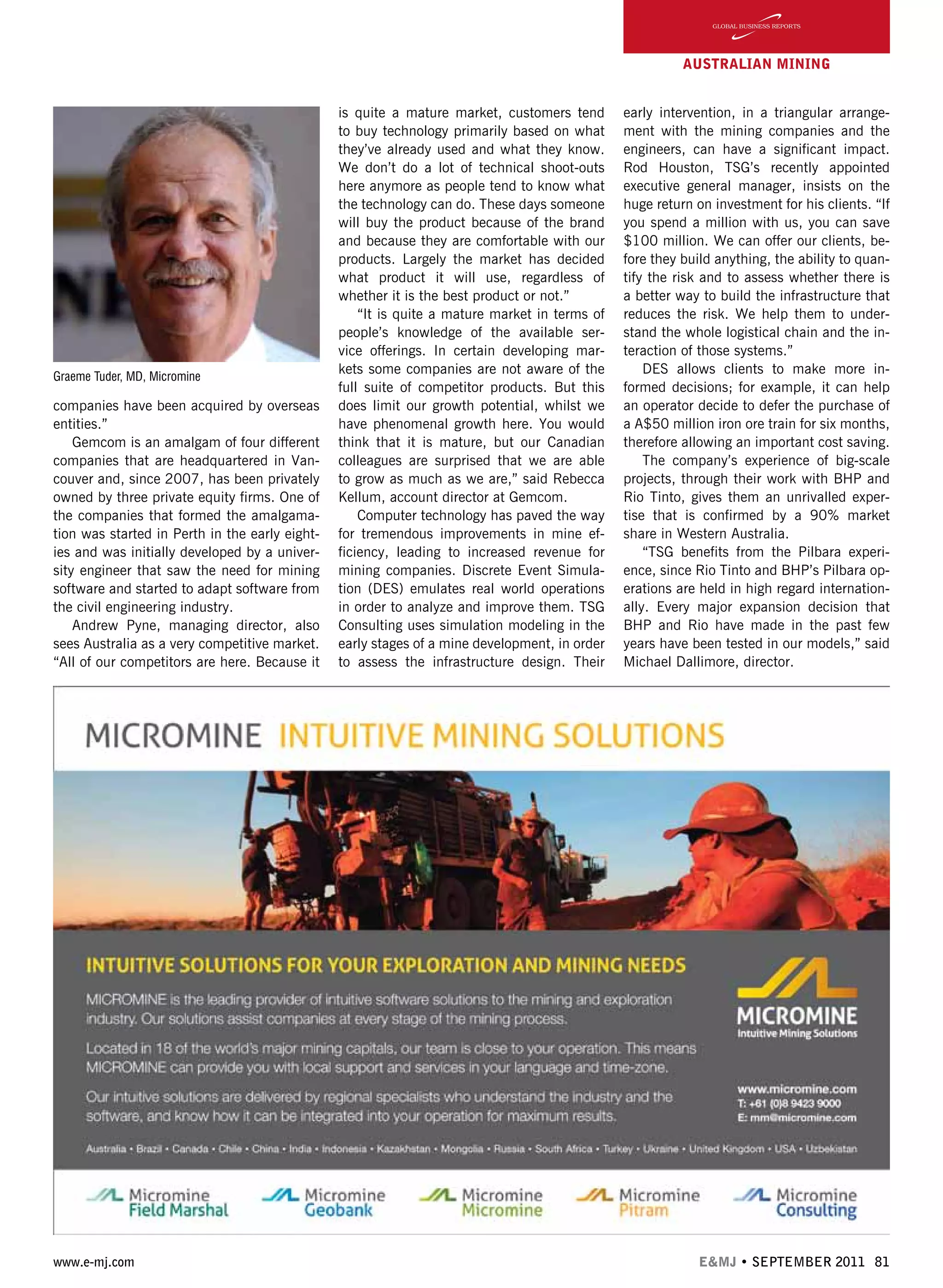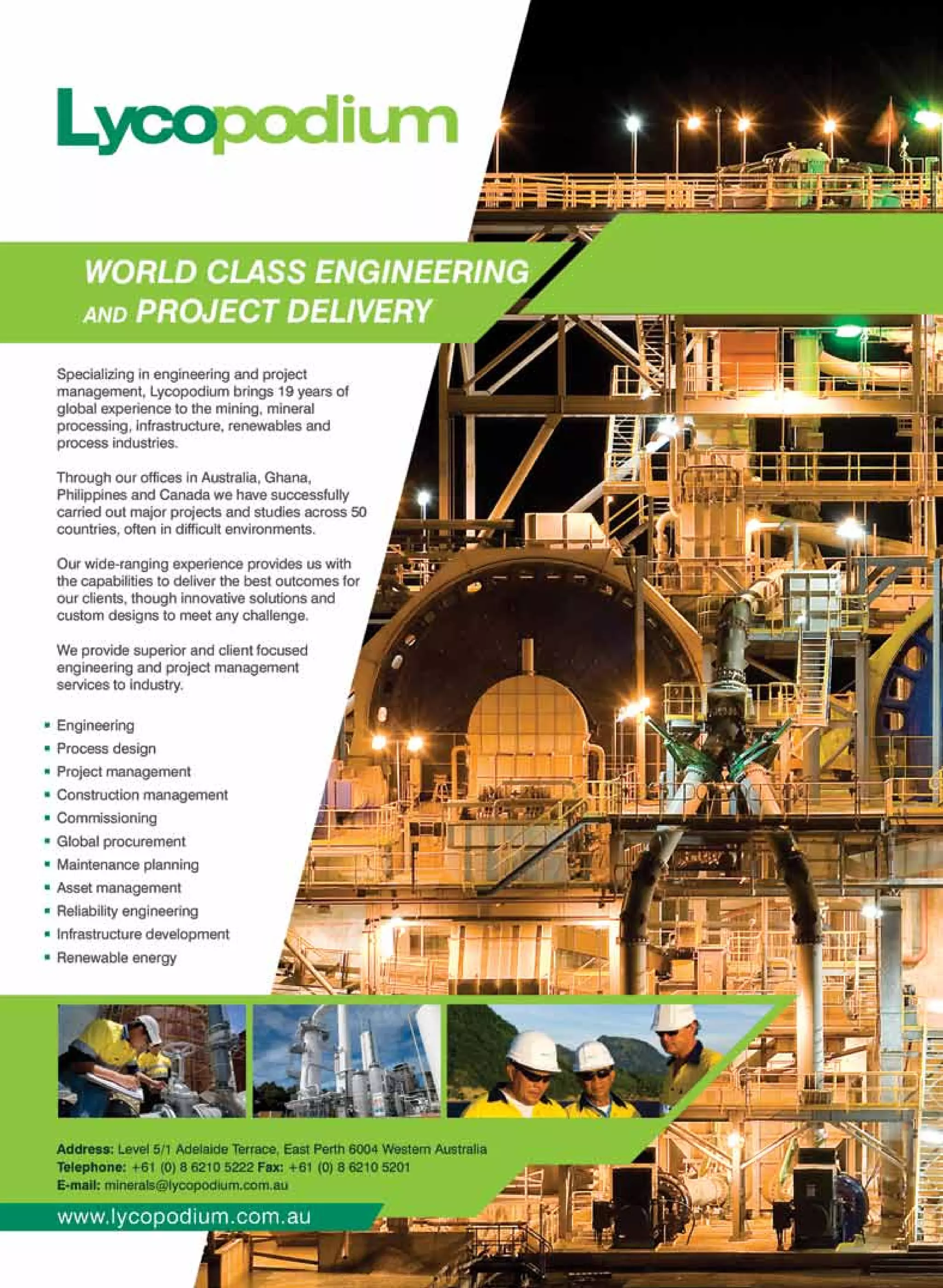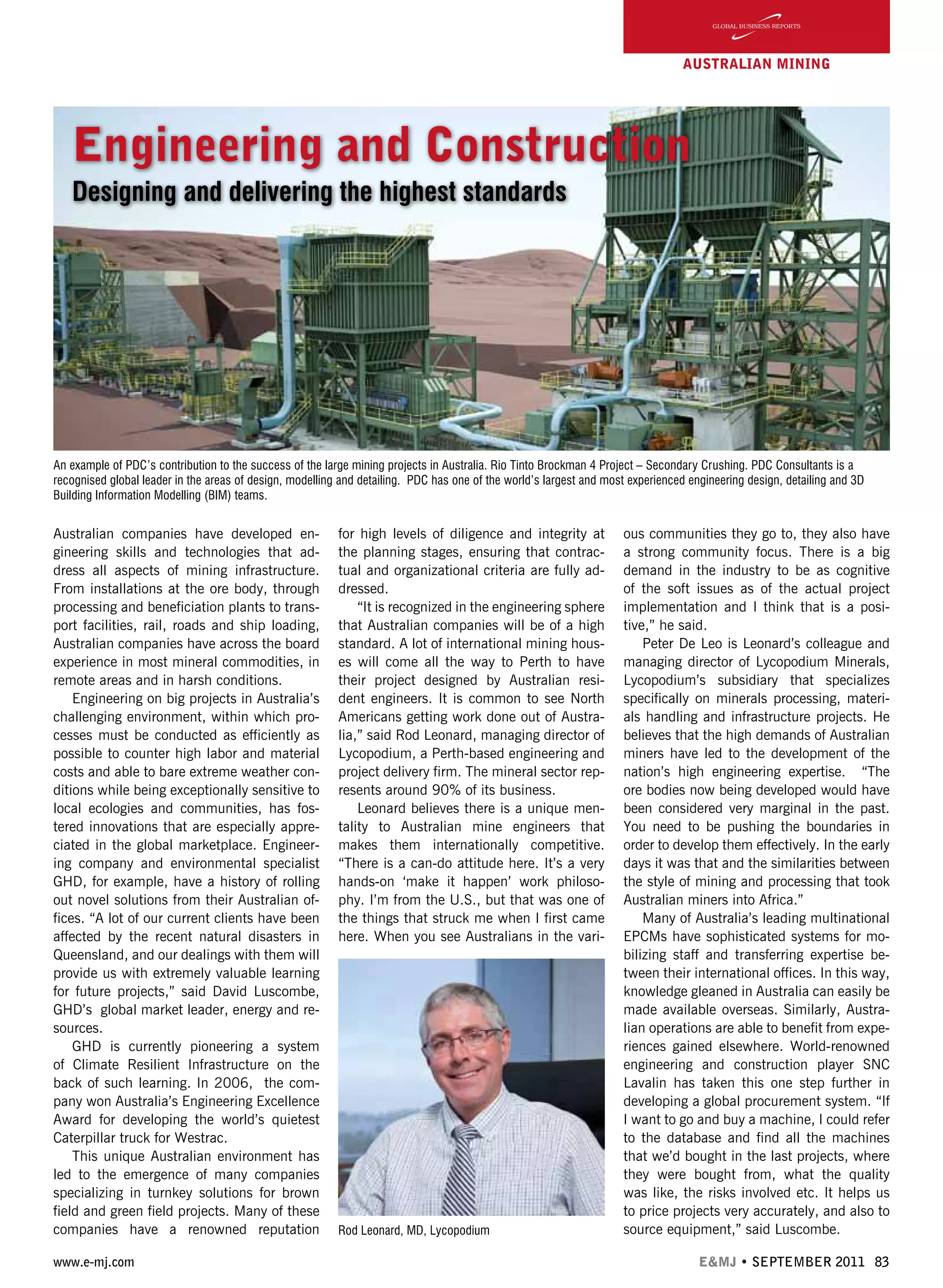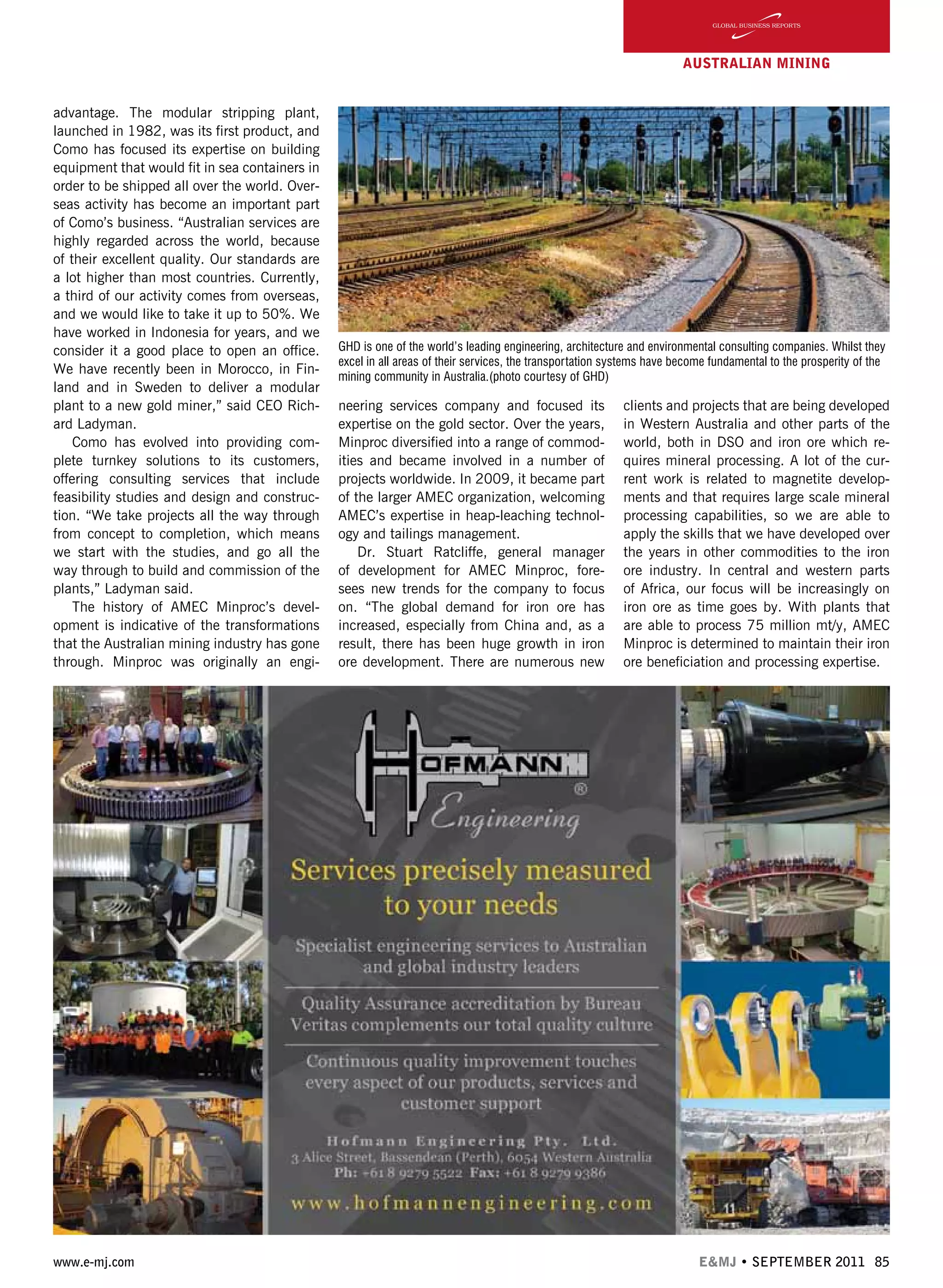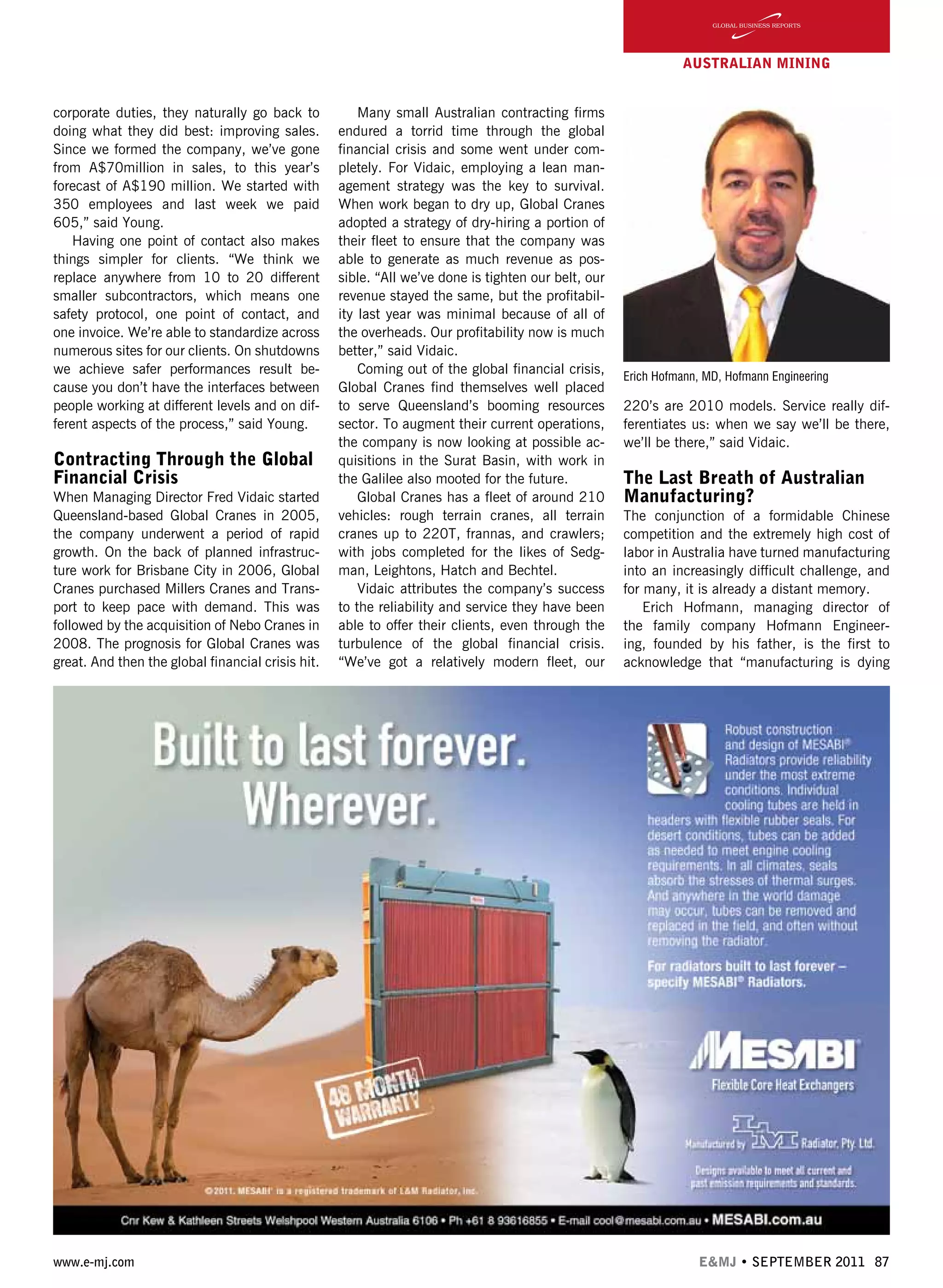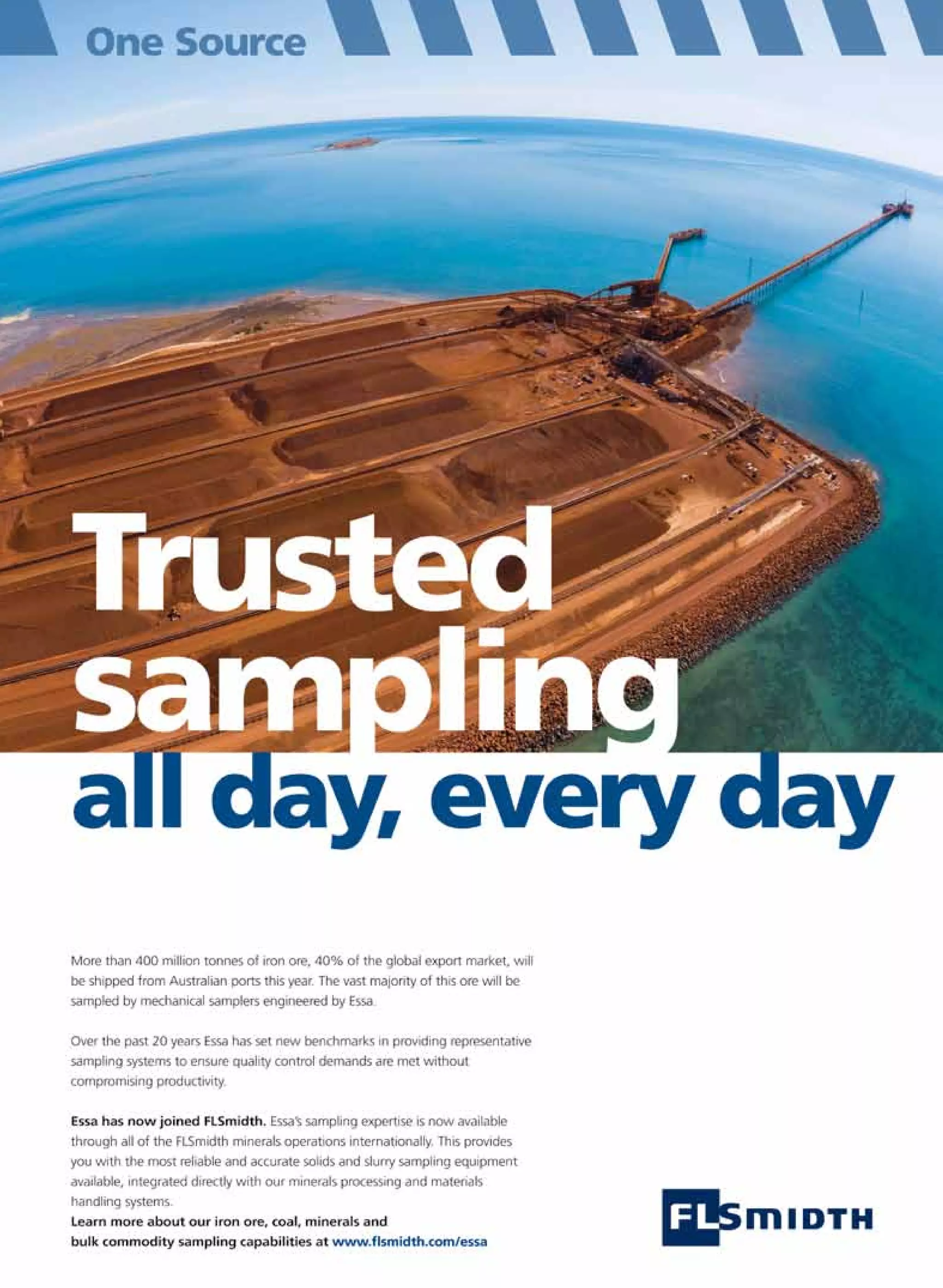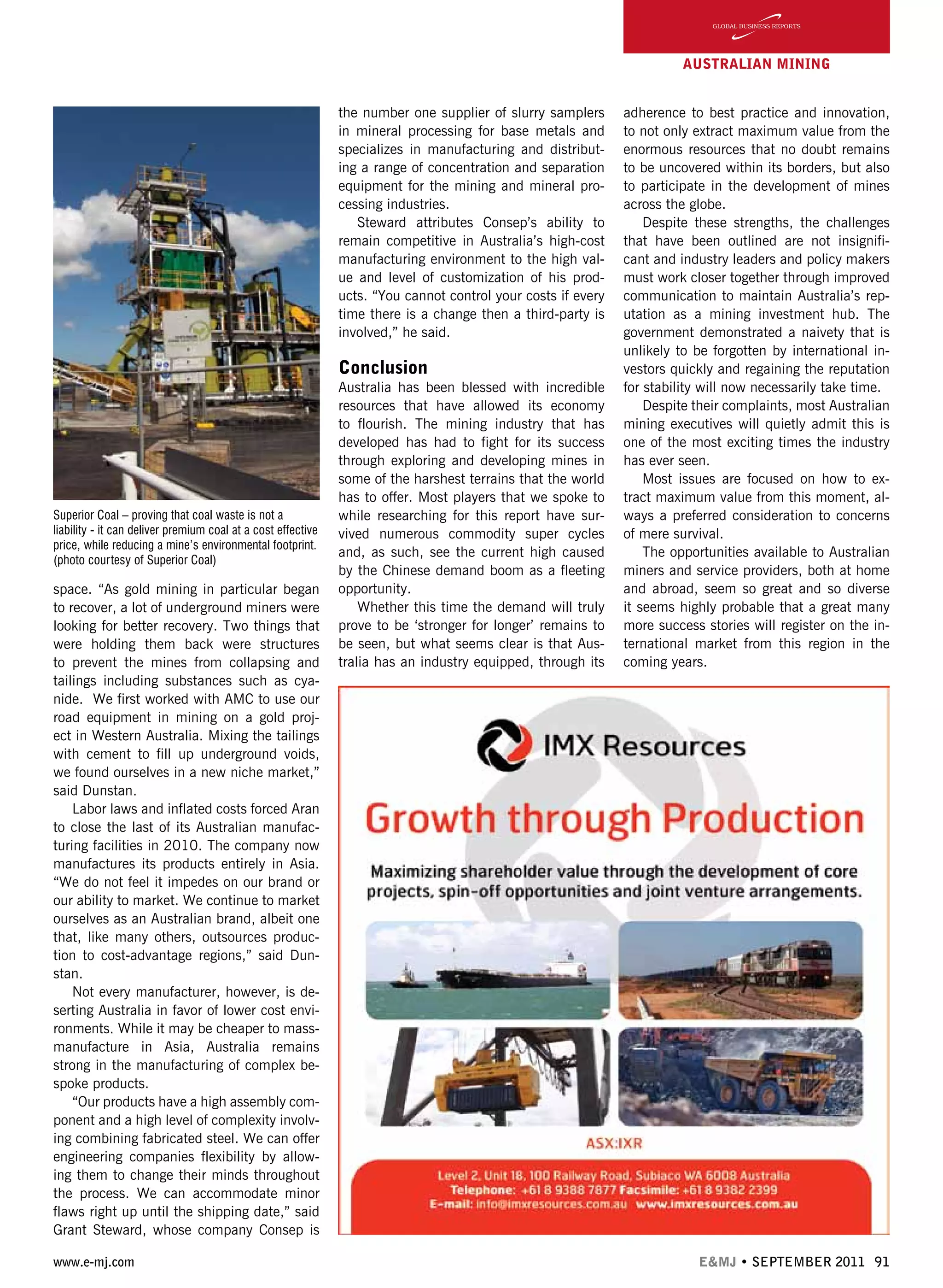This document provides an overview and summary of the mining industry in Australia. It discusses that Australia has abundant natural resources and is a major global producer and exporter of resources like iron ore, coal, gold, and uranium. It notes that while Australia is currently experiencing a mining boom, the industry faces challenges related to rising costs and regulatory uncertainty. The document summarizes some of the key opportunities and risks for mining investment in Australia.
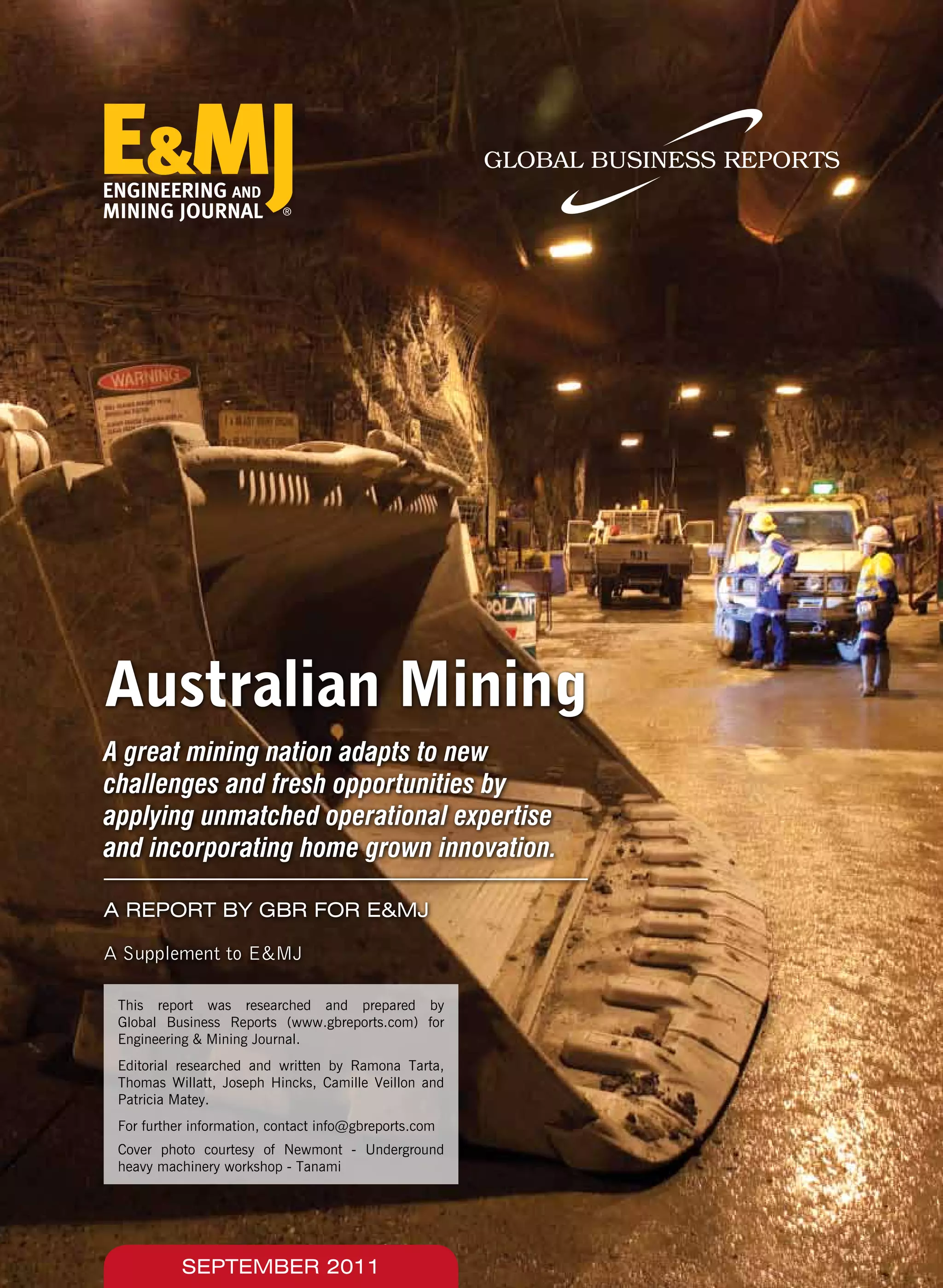
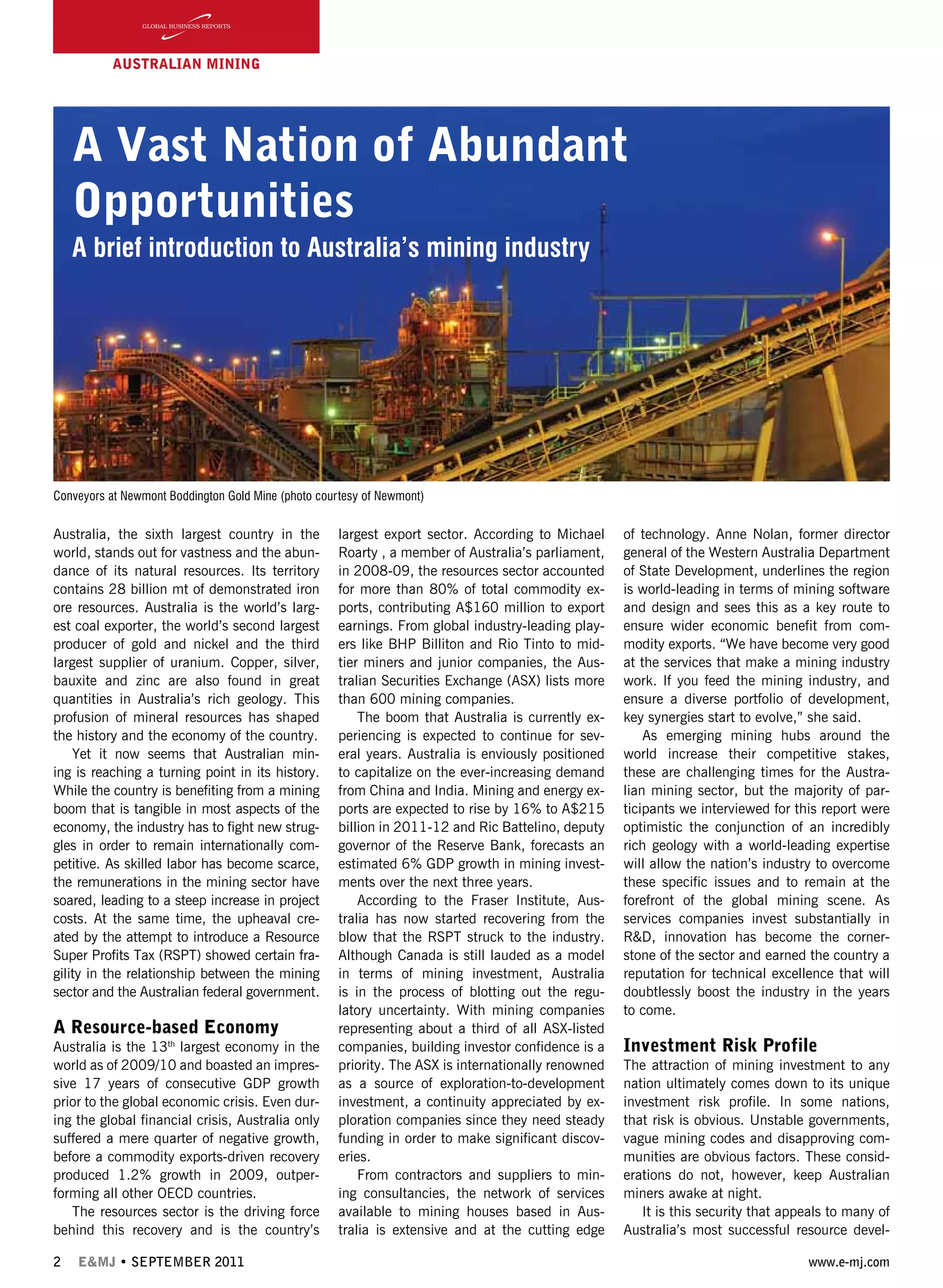
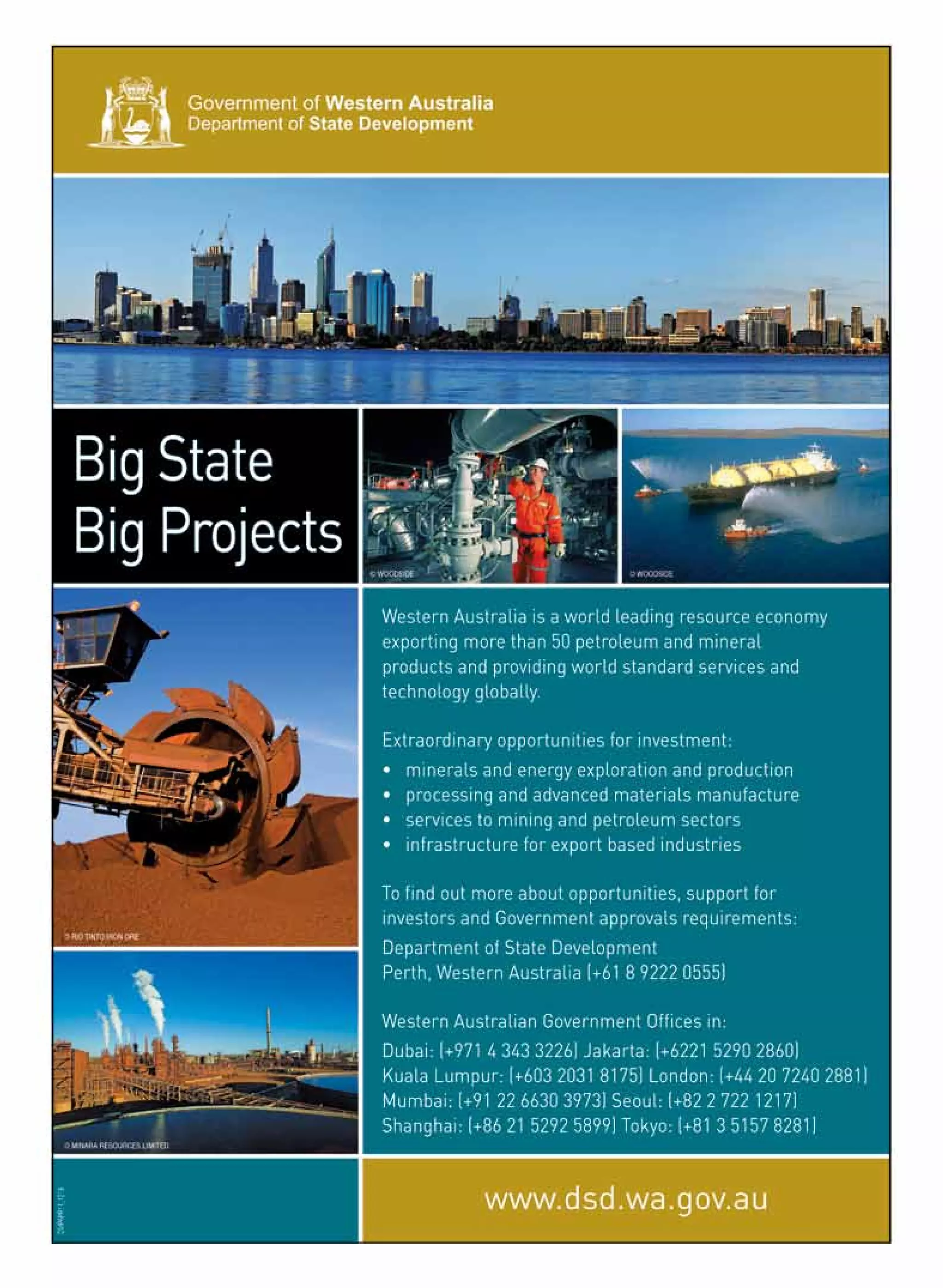
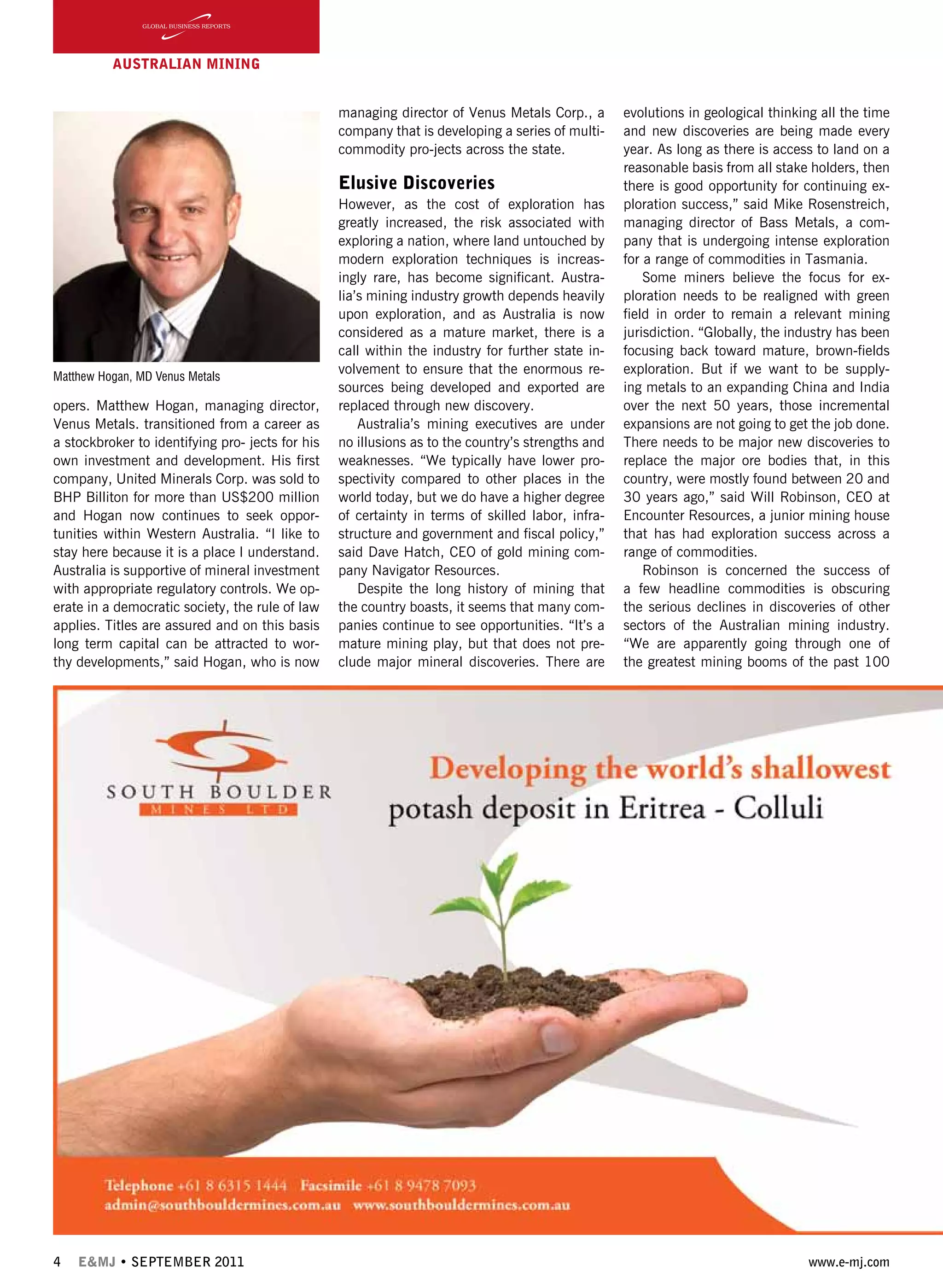
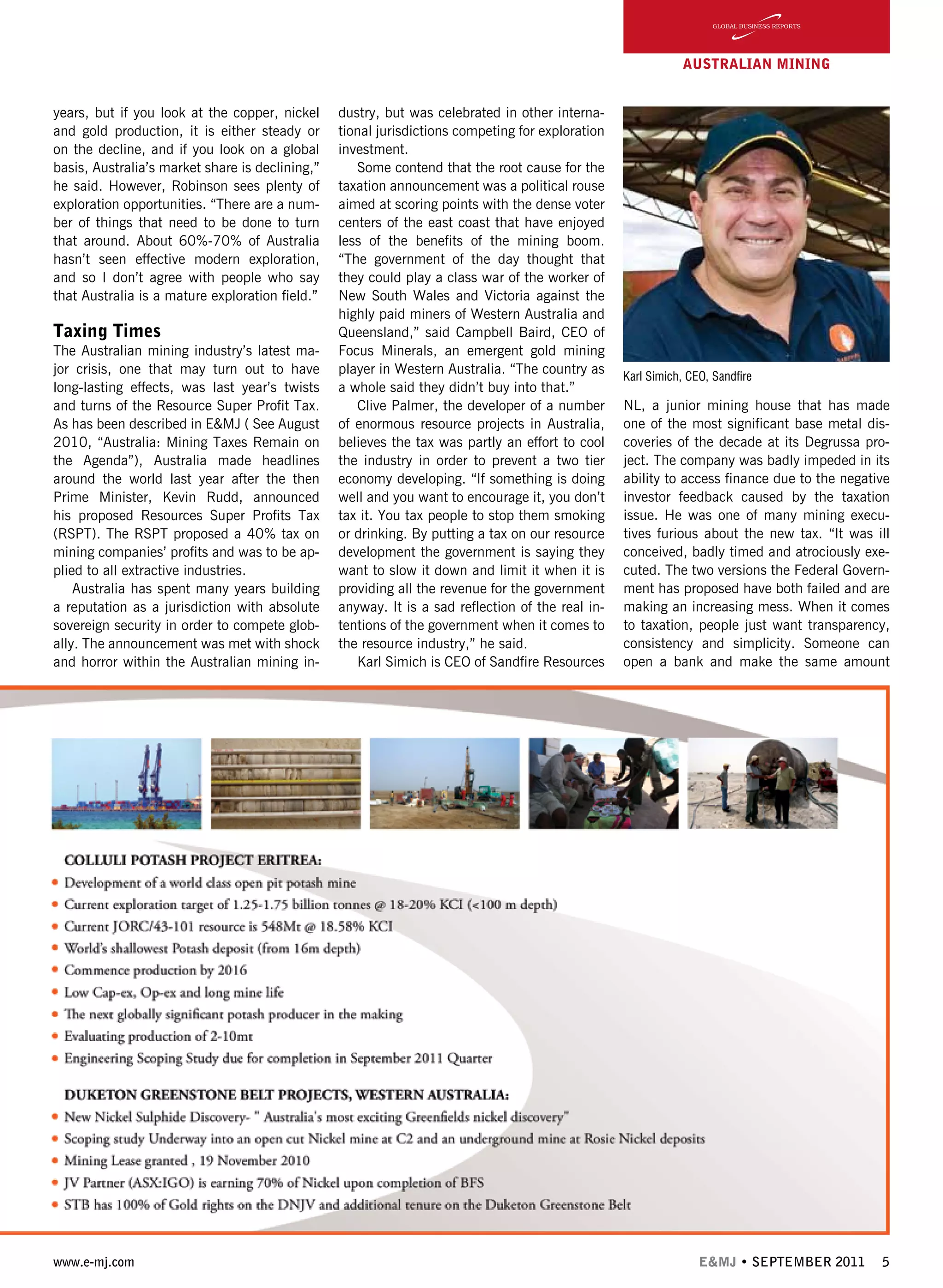
![6 E&MJ • SEPTEMBER 2011 www.e-mj.com
AUSTRALIAN Mining
of profit as me and pay half the amount of
tax I’m paying. I don’t understand the logic
behind that,” said Simich.
Aftermath
In response to the RSPT announcements,
the Australian mining industry did not re-
main silent. Across Australia, industry
groups such as the Association of Mining
and Exploration Companies (AMEC) experi-
enced an enormous increase in membership
as large players and small tried to correct
the misconceptions that had developed.
It is generally understood that the failure
of the RSPT led to Kevin Rudd’s Labor par-
ty’s decision to replace him as party leader
and Prime Minister with Julia Gillard, due
to the fear that the issue might seriously
damage their re-election campaign.
“Democracy worked beautifully and the
government almost became unelected be-
cause of this tax. It was so misconceived
and not properly thought through and it
caused a huge uproar from all sectors,” said
Russell Scrimshaw, director at Fortescue
Metals Group, the company that represents
perhaps the greatest iron ore success story
in Australia of recent times.
Once in power, Gillard announced a revi-
sion of the policy and set up a Policy Tran-
sition Group (PTG) made up of a number
of leading industry figures and also entered
into negotiations with a selection of leading
companies.
On July 2, 2010, the Australian Govern-
ment announced its intention to introduce a
new Minerals Resource Rent Tax (MRRT).
This has been greeted with a greater level of
acceptance from the industry. It represents
a 30% tax, limited to iron ore and coal min-
ing companies, that is to be introduced in
July 2012.
However, both the new design of the tax
reform and the manner in which it was cre-
ated continue to draw criticism from some
quarters. The PTG was led by the former
BHP Billiton Chairman, Don Argus, and was
felt to contain only representatives of Austra-
lia’s long established majors. This has led to
criticism from those that believe Australia’s
major mining companies already wield ex-
cessive power among policy makers.
Fortescue’s executives have been a lead-
ing voice in these criticisms. “The way that
it was renegotiated through consultancy
with only a few major players is fundamen-
tally wrong. We’ll keep fighting this as hard
as we can and we have a formidable team
here that are able to communicate and de-
fend our position,” said Scrimshaw.
It remains to be seen whether the MRRT
will enter into law, but it does seem to at-
tract significantly less criticism than its
earlier embodiment. The immediate impact
of last year’s investment scare was not felt
greatly in this year’s mineral output.
The real cost of 2010’s policy hiccup
may be felt much further along the line. It
was junior explorers and early developers
that felt the brunt of investor backlash. It
may be impossible to tell how great a loss
that represented for the country. The sector
can only hope that the Australian govern-
ment has learnt a lesson from the impact
that such ill-considered tax grabs can have.
The Carbon Tax
On July 9, 2011, after months of specu-
lation and pre-emptive debate, Australian
Prime Minister Julia Gillard unveiled details
of a plan to price carbon emissions. The
carbon price aims to push Australia toward
a clean energy future by reducing carbon
emissions by 160 million mt/y by 2020
and encouraging investment in less pollut-
ing energy generation methods. Though a
substantially different piece of legislation to
the RSPT, the carbon tax has evoked a furor
that, on the surface at least, is reminiscent
of Kevin Rudd’s 2010 proposition.
If the carbon tax is passed through par-
liament - for which the Labour government
would require the support of the Greens and
independents - a flat charge of A$23 per
mt of carbon emissions will be levied on
Australia’s top 500 polluters. In 2015, the
tax will be replaced with a market-driven
Emissions Trading Scheme. Fuel suppliers
and distributors, and companies emitting
synthetic greenhouse gases, including the
refrigeration and air-conditioning industries,
are exempt. The mining sector will be espe-
cially affected by the off-road diesel fuel re-
bate being pared back by $0.06/liter, which
the industry says is a 16% increase in the
fuel tax.
Mitch Jakeman, CEO of Carabella Re-
sources, a Queensland coal player with in-
terests at Mabbin Creek, says that for a long
time the coal industry had broadly acknowl-
edged that something needed to be done to
address carbon emissions. “The Australian
Coal Association actually moved a long way
towards the government to say that you
need to give us some signals and allow us
to invest in the heavy technology, to raise
R&D to 150%.”
Though the carbon tax makes provisions
for a A$1.3 billion assistance package to
aid the industry, this represents just 10%
of the A$18 billion that the Australian coal
industry will face over the next nine years
according to Anglo American, whose CEO
Seamus French has come out in strong op-
position to the tax.
“All of this technology is high-cost and
high-risk. We’re prepared to spend, but the
money needs to go back into those sorts of
things, not just renewables,” said Jakeman.
In May 2011, Xstrata announced plans
to shut down its smelting facility at Mount
Isa by 2016. While Xstrata CEO, Steve de
Kruijff, has previously stated that the com-
pany had taken the decision on the basis
of its inability to compete with lower cost
processing operations in China and not due
to the looming carbon tax, Michael Roche
told Australia’s ABC News in January that
the closure demonstrated how tough the
market was becoming for Australian compa-
nies. “This just shows you just how vulner-
able [the industry] can be to additional cost
imposts, which is why of course we’re trying
to fend off the worst of the carbon tax at the
moment. Without our competitors also hav-
ing some sort of carbon pricing mechanism,
it’s just going to get harder and harder for us
to compete,” said Roche.
Gillard acknowledges the introduction
of a carbon tax was a hard call to make,
but maintains that cutting carbon emissions
in such a way is necessary for Australia’s
future. Treasurer Wayne Swan has said
Australia’s low unemployment, record trade
and a strong investment pipeline made the
introduction of a carbon tax feasible in the
face of global economic uncertainty. One
of the main points of contention in the re-
sources industry is that without other ju-
risdictions limiting their carbon emissions,
Australia will lose market share to its com-
petitors, particularly in the coal space, with-
out necessarily contributing to a reduction
in global carbon emissions. “Any mt of coal
that doesn’t get sold here will get sold from
somewhere else. It will be less clean than
the Australian coal, therefore the actual
amount of CO2
will be greater,” said Rob
Neale, CEO of New Hope Coal.
If passed through parliament, the carbon
tax will take effect July 1, 2012. The de-
bate continues.
Russell Scrimshaw, Director, Fortescue](https://image.slidesharecdn.com/28c63d64-5f49-4b1f-829f-d9d98c27c114-160115062504/75/Australia_Mining-2011-6-2048.jpg)
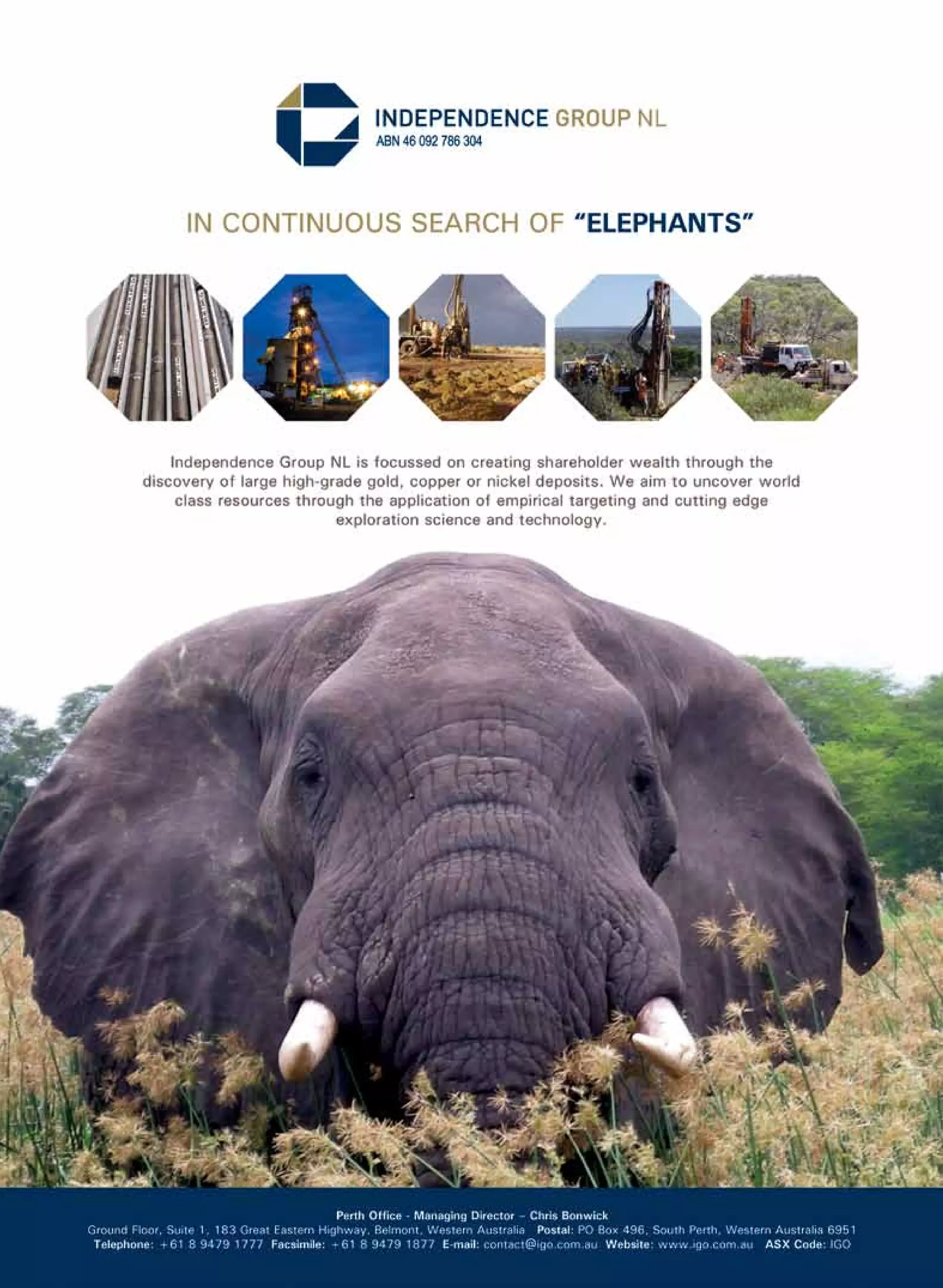
![8 E&MJ • SEPTEMBER 2011 www.e-mj.com
AUSTRALIAN Mining
Accessing Australia’s Resources
Navigating a sea of green and red tape
Australia is a nation blessed with a unique
environment and ecosystem rich with flora
and fauna found nowhere else on the planet,
largely due to its long history of isolation.
Australians take great pride in the unique
beauty of this environment and, as such,
great pains are taken to ensure that Aus-
tralia boasts a highly responsible mining in-
dustry that protects this environment. “The
convergence of first world living standards,
high-population growth and lots of resource
availability means we’ve got an environmen-
tal framework that is probably ahead of the
rest of the world,” said John Douglas, man-
aging director of Coffey International, one of
the world’s foremost geo-scientific consul-
tancy companies.
In addition, Australia’s colonial past has
left a legacy of complex relations between
the country’s cosmopolitan population of im-
migrant descendants and the island’s origi-
nal aboriginal communities. After genera-
tions of poor and, in some cases, deplorable
treatment of the country’s indigenous popu-
lation, modern Australia is keen to protect
and advance its Aboriginal and Torre Strait
Islander communities and the sites that
contain historical or spiritual significance to
their indigenous cultures.
Together, these noble intentions translate
into a sea of green and red tape that must
be navigated by any prospector, explorer
or developer hoping to deliver a project on
time and on budget in any corner of the
vast Australian Outback. However, there are
those that see this is as an eventual strength
of Australian projects. “There are perhaps
more regulatory hurdles to get through than
in other markets, but often that’s also a good
thing. In some emerging mining hubs it is
easier to get approvals, but there is also less
certainty that those approvals can be relied
upon. It’s a trade-off between ease of access
and the fact that rights are more tenuous,”
said Andrew Caruso, CEO, Crosslands, a
company developing a large iron ore mine in
the Mid-west region.
For mining consultancy companies op-
erating in other jurisdictions, experience in
negotiating the notoriously rigorous environ-
mental regulatory framework in Australia
provides a firm foundation for undertaking
complex projects overseas. “[Australia] has
been a good market to cut our teeth,” said
Douglas.
Although this solid footing on which to
build projects can be considered a strength,
it is unnecessary delays or duplication
among government approval offices that
most irritates explorers, developers and pro-
ducers alike. It is an issue policy makers are
aware of and are working on improving. “We
appreciate there is a window of opportunity
to resource projects and we need to ensure
that our approvals process can enable that,”
said Nolan.
In Queensland, the approvals process is
regarded as particularly complex. “When
you look at a mega-project, there are up to
1,800 permits and approvals to go through.
It’s ridiculous. We’re all about doing what’s
right for the environment, but there comes
a point where you need to stop road block-
ing and start facilitating,” said Paul Mulder,
managing director of Hancock Coal.
Changes in legislation pertaining to land
access have been especially criticized by
the mining industry. While miners broadly
accept that landowners need to be com-
pensated, many are unhappy with the am-
biguity of the legislation introduced by the
state government on the back of landowner
pressure, and according to Mitch Jakeman,
managing director at Carabella Resources,
the failure of that legislation to distinguish
between coal seam gas and coal explora-
tion. “The government put in legislation that
left a lot of grey areas for interpretation. The
fact is that they didn’t risk assess upstream
and downstream, and they didn’t examine
the impact that the legislation was going to
have on treasury. It will have a whole range
of downstream implications in terms of rev-
enue coming to the government. The legisla-
tion created new land rights for landowners
that it wasn’t supposed to. It also conflicted
the exploration direction the government
wanted,” said Jakeman.
Rob Neale, CEO of New Hope Coal, which
has open cut coal mines in Queensland’s
Ore stockpile at Newmont’s Boddington mine (photograph courtesy of Newmont)
Paul Mulder & Gina Rinehart
MD & Chairman, Hancock Coal](https://image.slidesharecdn.com/28c63d64-5f49-4b1f-829f-d9d98c27c114-160115062504/75/Australia_Mining-2011-8-2048.jpg)
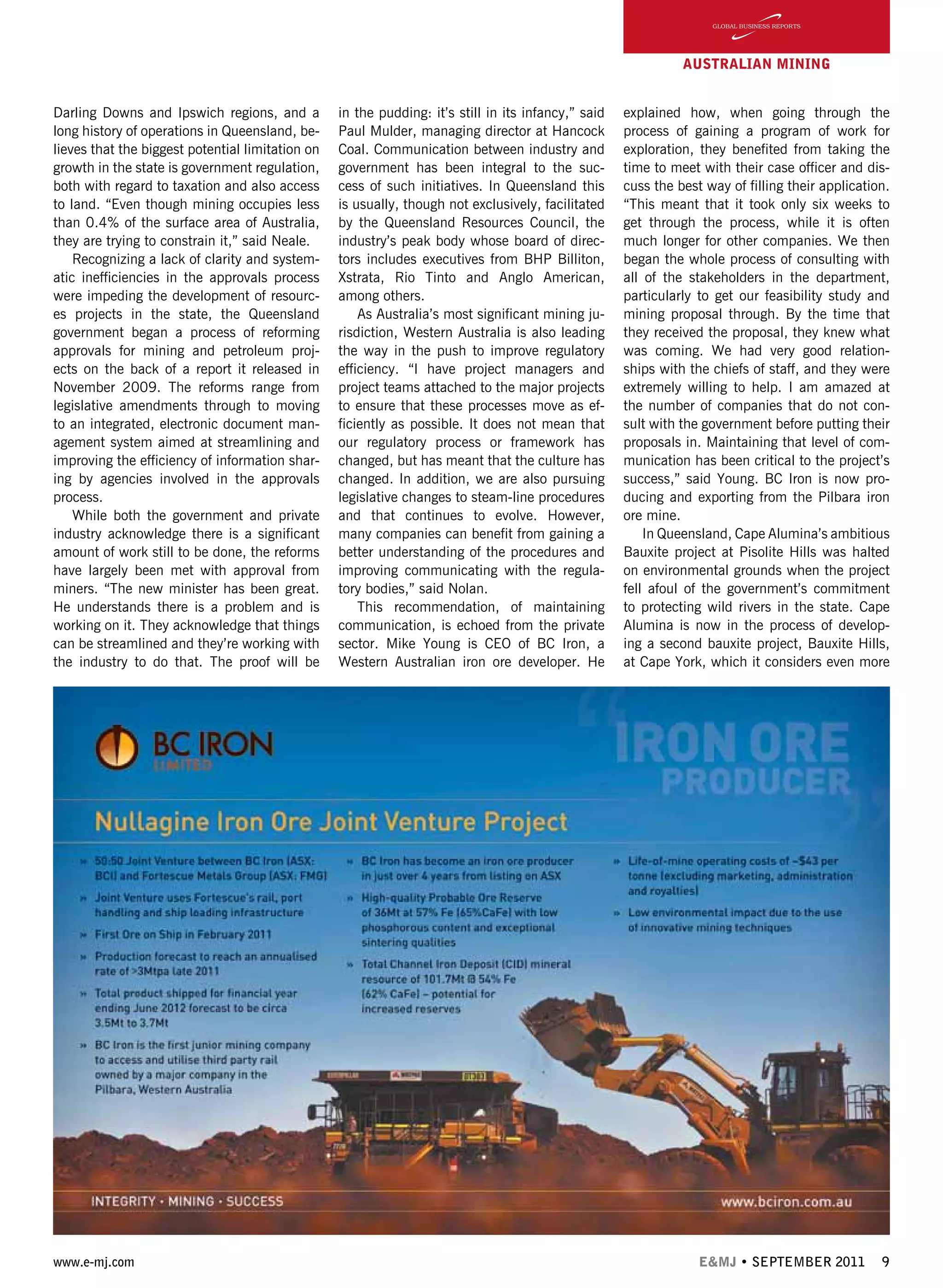
![10 E&MJ • SEPTEMBER 2011 www.e-mj.com
AUSTRALIAN Mining
prospective than Pisolite Hills. According
to Cape Alumina CEO, Neville Conway, the
company is going to great pains to ensure
its planning is meticulous in terms of com-
munity impact. “We are front-end loading
our permitting right now to make sure that
all people are supportive of our endeavors.
Our strategy is simple; to build a coalition of
support for the project and enable everyone
to enjoy the social and economic benefits
it will bring and to ensure we maintain our
high standards to environmental protection
and rehabilitation and mitigation,” he said.
The emphasis Australia places on the
protection of its natural environment pres-
ents a wealth of opportunities for consul-
tancy companies, particularly those who
have been entrenched in the country long
enough to develop expertise. “It is going to
get tougher and tougher to get resources
consented. The community is increasingly
holding mining companies to very high
standards, probably as it should be. For us,
[environmental approvals are] a very strong
growth area. The parts of the mining cycle
that we service are the complex ones. Get-
ting someone who has deep experience with
the local legislation and has credibility is vi-
tal when it comes to environmental approv-
als,” said Douglas.
Mining in Australia has frequently led to
conflict with indigenous groups over owner-
ship of land and resources. Much of Aus-
tralia’s mining takes place in remote areas,
including the Outback, where aboriginal
people form a high percentage of the pop-
ulation. Aboriginal people have protested
against mining activity that disturbs or de-
stroys sacred sites, causes environmental
damage, or negatively affects the customs of
aboriginal communities.
In reference to social issues associated
with Australia’s aboriginal communities,
many companies recommend a proac-
tive approach. At Newmont, for example,
Jeff Huspeni, senior vice president for Asia
Pacific operations, takes great pride in its
Corporate Social Responsibility (CSR) de-
partment. “We regard CSR as one of our
competitive advantages. We have a culture
of active involvement in the communities in
which we operate. We have an Aboriginal
Partnership Strategy which drives the com-
pany’s approach and actions for greater Ab-
original participation at our operating sites,
regional office and other locations where we
have exploration interests and closed sites.
The strategy is built around four key pillars
of empowerment, engagement, employment
and enterprise development,” he said.
More than employment alone, it is the
training that Huspeni sees as most impor-
tant. “It enables individuals to move into
increasing roles of responsibility within the
company.”
At Bauxite Hills, Cape Alumina is work-
ing closely with the community surrounding
Cape York in determining how the anticipat-
ed A$1 billion of economic net benefit the
project is expected to generate will effect
citizens. “The people of Western Cape York
are coming off a very low base economically.
The aboriginal peoples of Western Cape York
are among some of the most socially and
economically disadvantaged in our country.
We work closely with the local communities
to ensure that they understand the param-
eters of our project and both the benefits it
can bring and its limitations with regard to
wealth generation. 89% of the aboriginal
residents of Mapoon wanted to work on our
Pisolite Hills project,” said Neville Conway,
CEO of Cape Alumina.
These examples show the keen empha-
sis Australian miners need to place on both
environmental and community issues. It is
also an issue that only seems to be gaining
in importance as stakeholders are supported
by increasingly powerful global NGO groups.
However, the benefit is that Australian min-
ers gain a profound understanding of these
issues that reduce investment risk and equip
them for projects in other environmentally
sensitive areas or jurisdictions with compli-
cated community issues.
Rio Tinto, for example, is the largest non-
governmental employer of aboriginal people
in Australia. According to John McGagh,
head of innovation at Rio Tinto, sensitivity
to the needs of local populations perme-
ates the company’s work overseas. “Further
afield, when we move into a new jurisdic-
tion we make fundamental agreements that
we will not break. We create local jobs, net-
works and feeder systems,” he said.
Almost universally throughout Austra-
lia’s mining industry, aspects of mining op-
erations that were formerly regarded as soft
skills; community engagement and environ-
mental best practice,-are becoming integral
to win a license to operate. Most successful
Australian miners have developed sophisti-
cated CSR initiatives to ensure that in con-
junction with taking resources out of a given
community, they are putting something
substantial back in return. Sonoma Mine
Management, for example, who operate the
Sonoma coal mine in Queensland’s Bowen
basin, have worked hard to contribute to the
community of Collinsville, 6 km north of the
mine site. “We’ve developed a community
grants program whereby members of the
community are able to receive support from
Sonoma Mine Management for the various
projects that they wish to get up and run-
ning. We process applications for that grant
program every month and are pleased to
be contributing where we can to what the
community is seeking to do. Sonoma Mine
Management has also engaged a local tour-
ism group to bring more tourism into our im-
mediate community area. Our impact on the
local environment is important to us so we
work very hard to ensure that we are ad-
dressing issues or concerns that the commu-
nity may raise,” said Chris Millard, general
manager at Sonoma Mine Management.
Community engagement is not the sole
preserve of miners. Australia’s leading con-
tractors and sub-contractors also regard
establishing good relationships with the
community as integral to the success of
their business. Queensland’s FK Gardener
has a strong heritage in civil infrastructure
construction and has recently moved into
the coal seam gas space with projects for
players such as Santos. Through its plant
division EzyQuip Hire, based in Brisbane,
Toowoomba, Mackay, Roma and Cairns, FK
Gardener supply equipment hire solutions to
mines across Queensland and expect to be-
come increasingly involved in mine develop-
ment infrastructure in the future.
FK Gardener conventionally purchases
housing for its employees in the towns in
which the company operates rather than
setting up worker camps. The company also
ensures local people are provisioning its
team. “With all the growth that’s happen-
ing [in western Queensland] it’s important
that the local community gets value out from
that. That’s why we have invested in the lo-
cal towns, it’s important to be closely con-
nected to the local community,” said Gary
Gardner, managing director at FK Gardener.
To cement this relationship, FK Gardener
provides all staff with an allowance for join-
ing local gyms or sports teams, ensuring that
that they become active participants in the
communities in which they reside.
Jeff Huspeni, Senior Vice President, Newmont Mining](https://image.slidesharecdn.com/28c63d64-5f49-4b1f-829f-d9d98c27c114-160115062504/75/Australia_Mining-2011-10-2048.jpg)
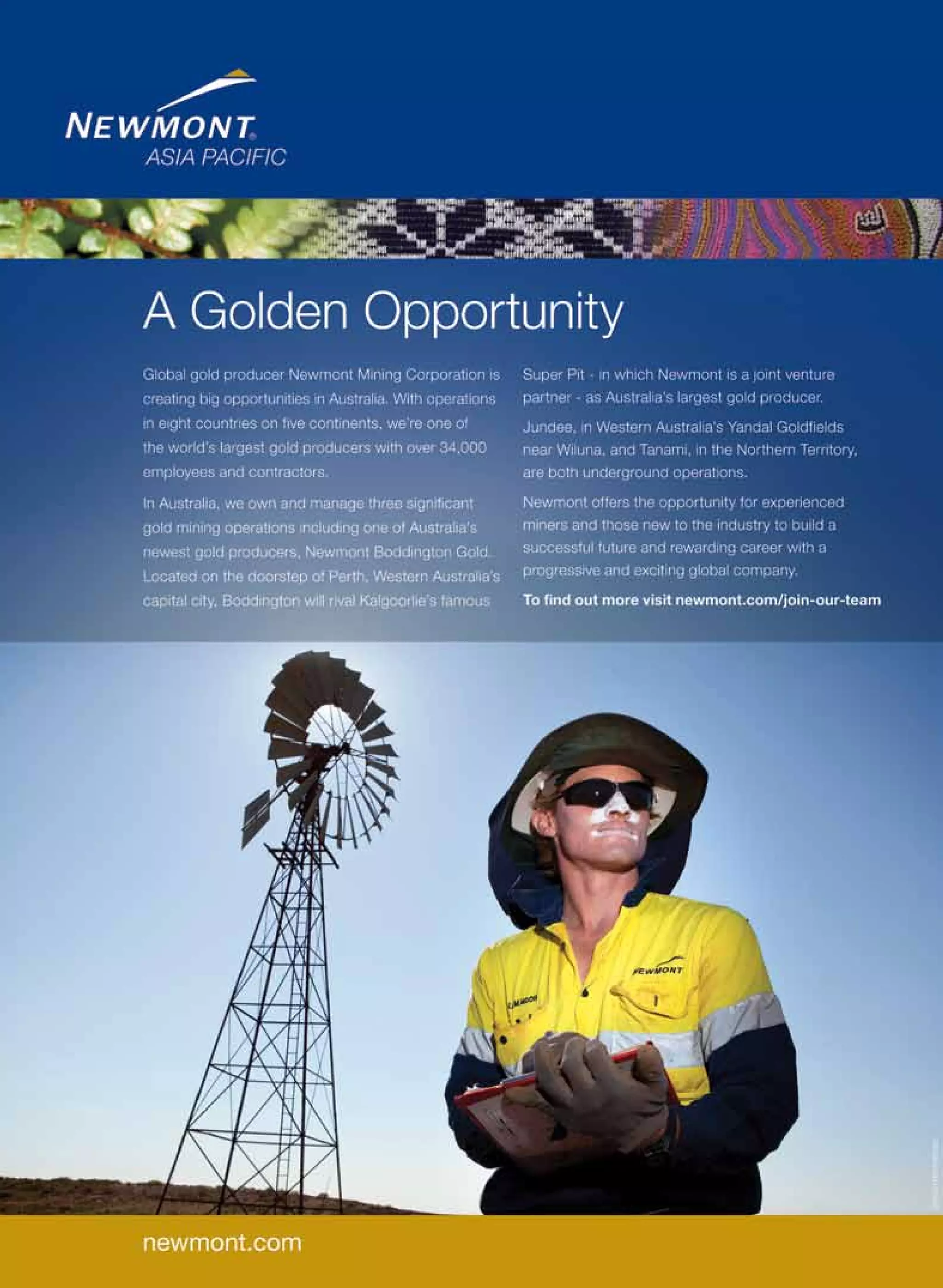
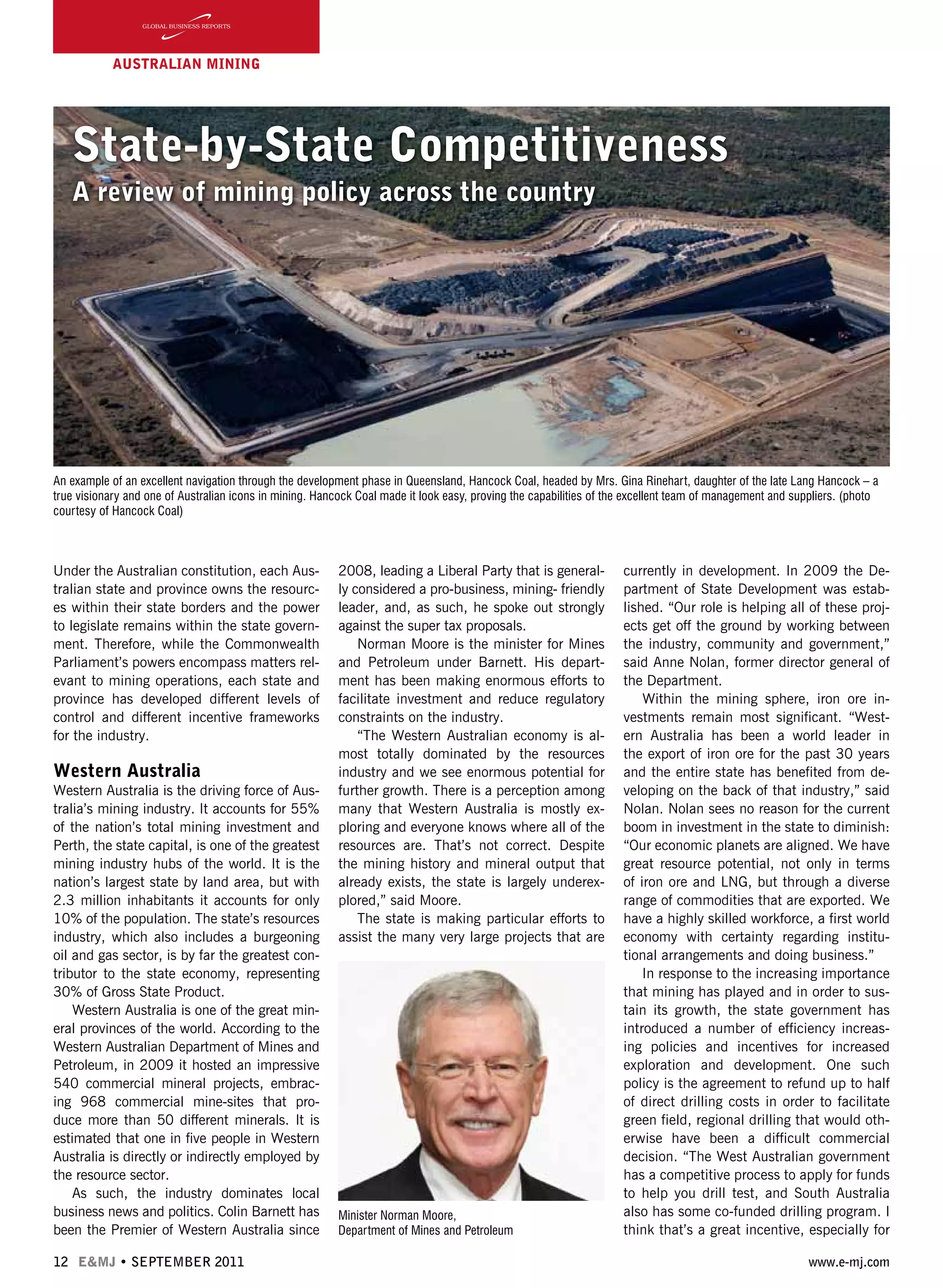


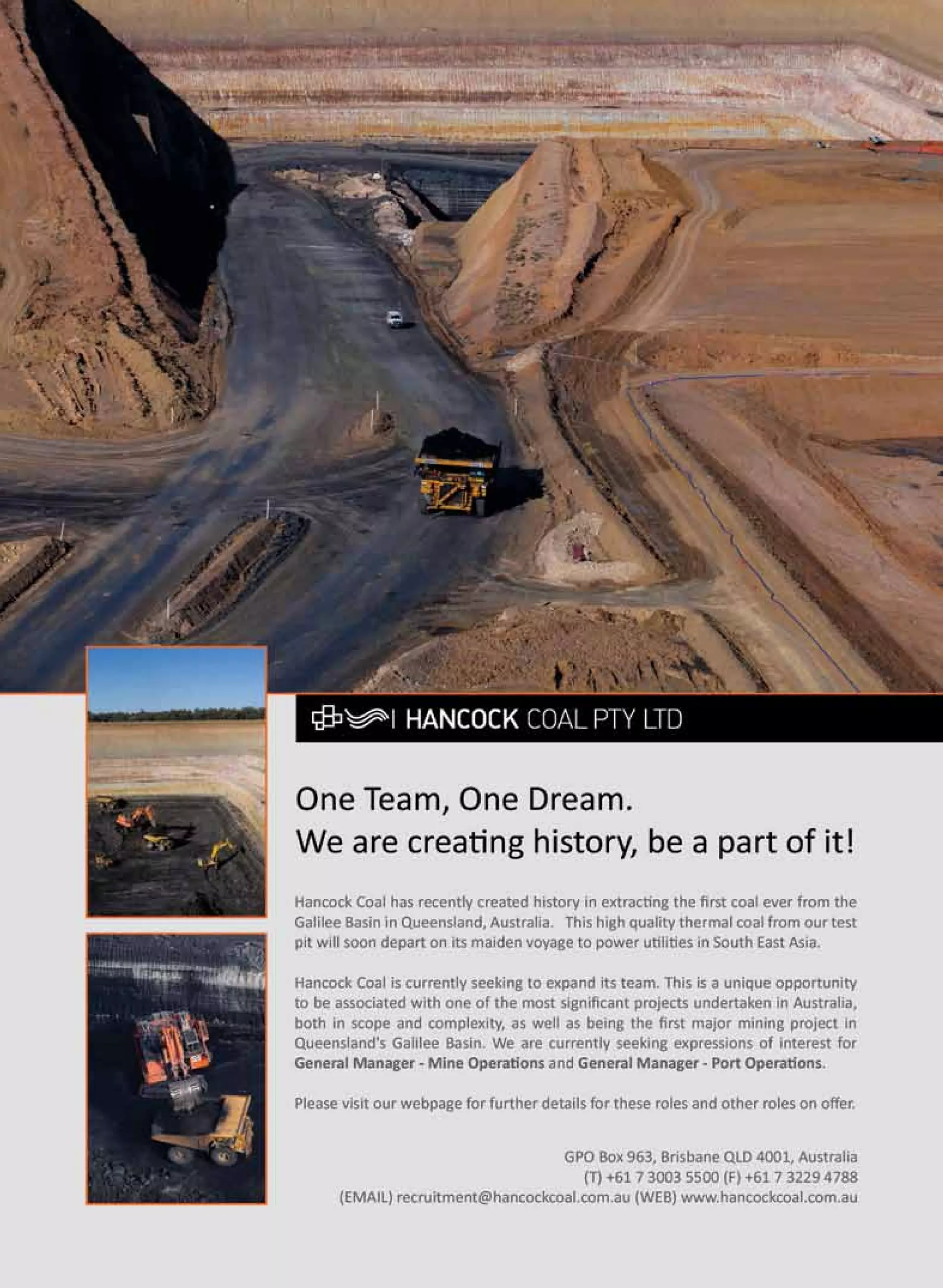

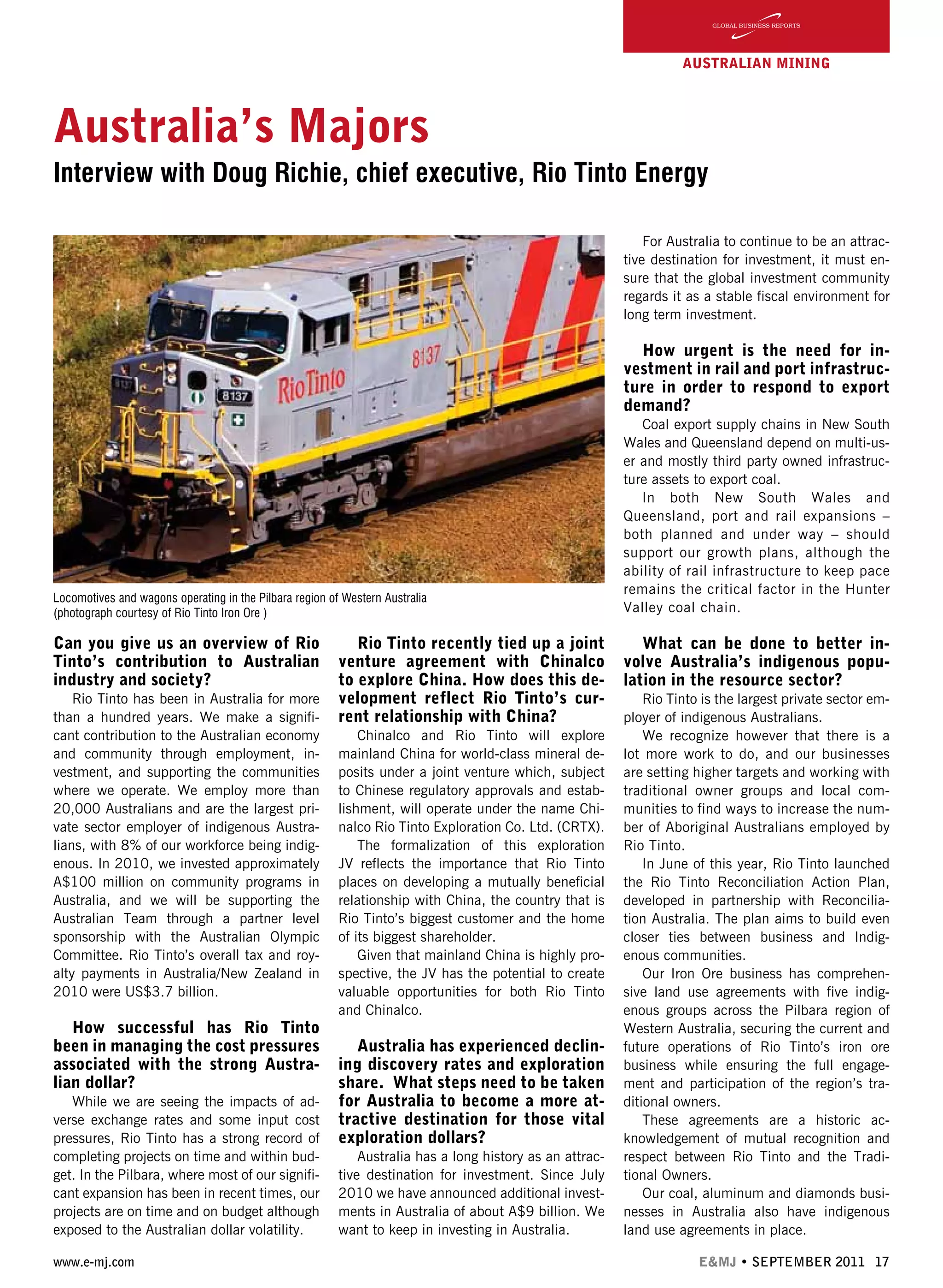




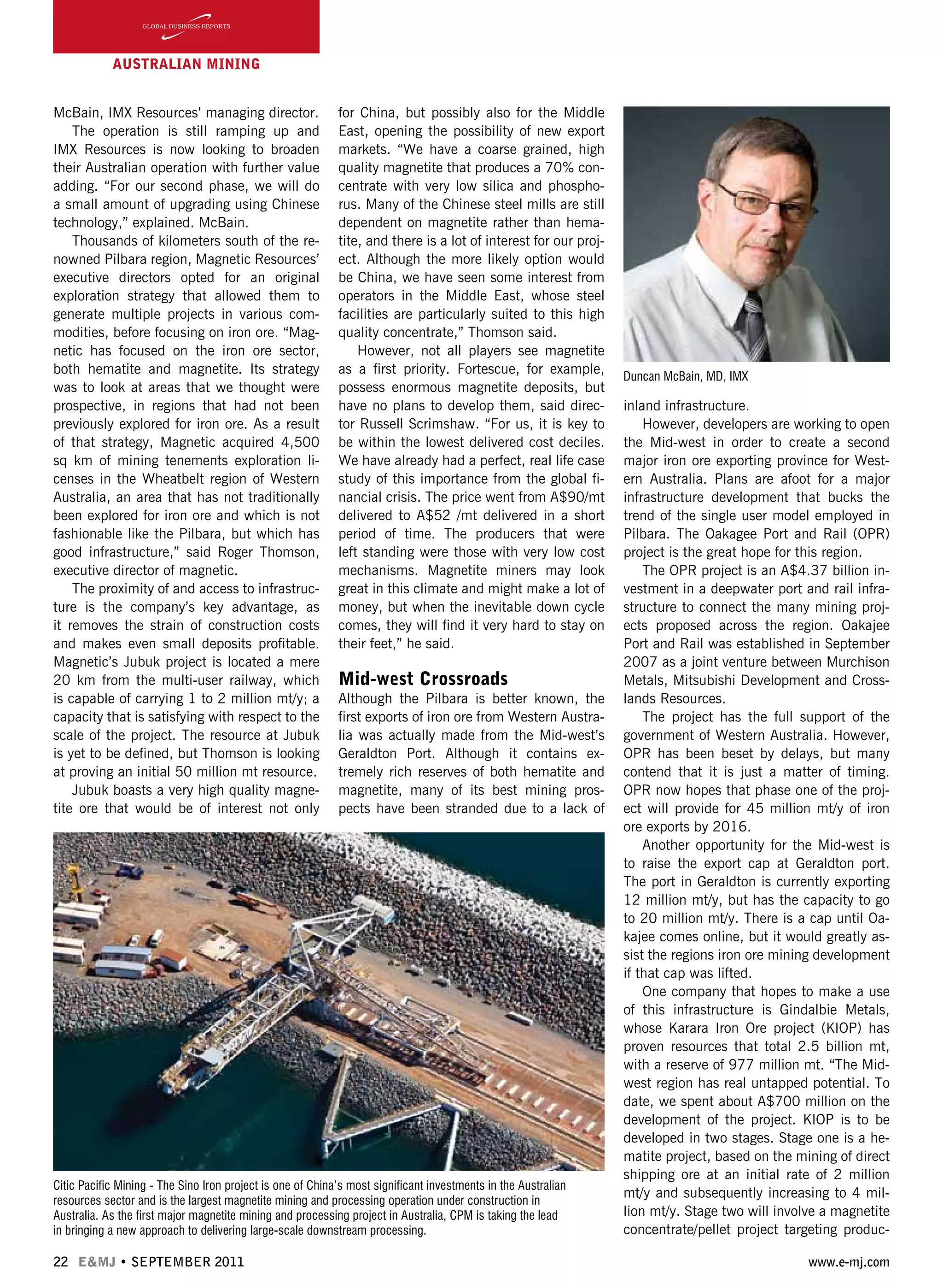



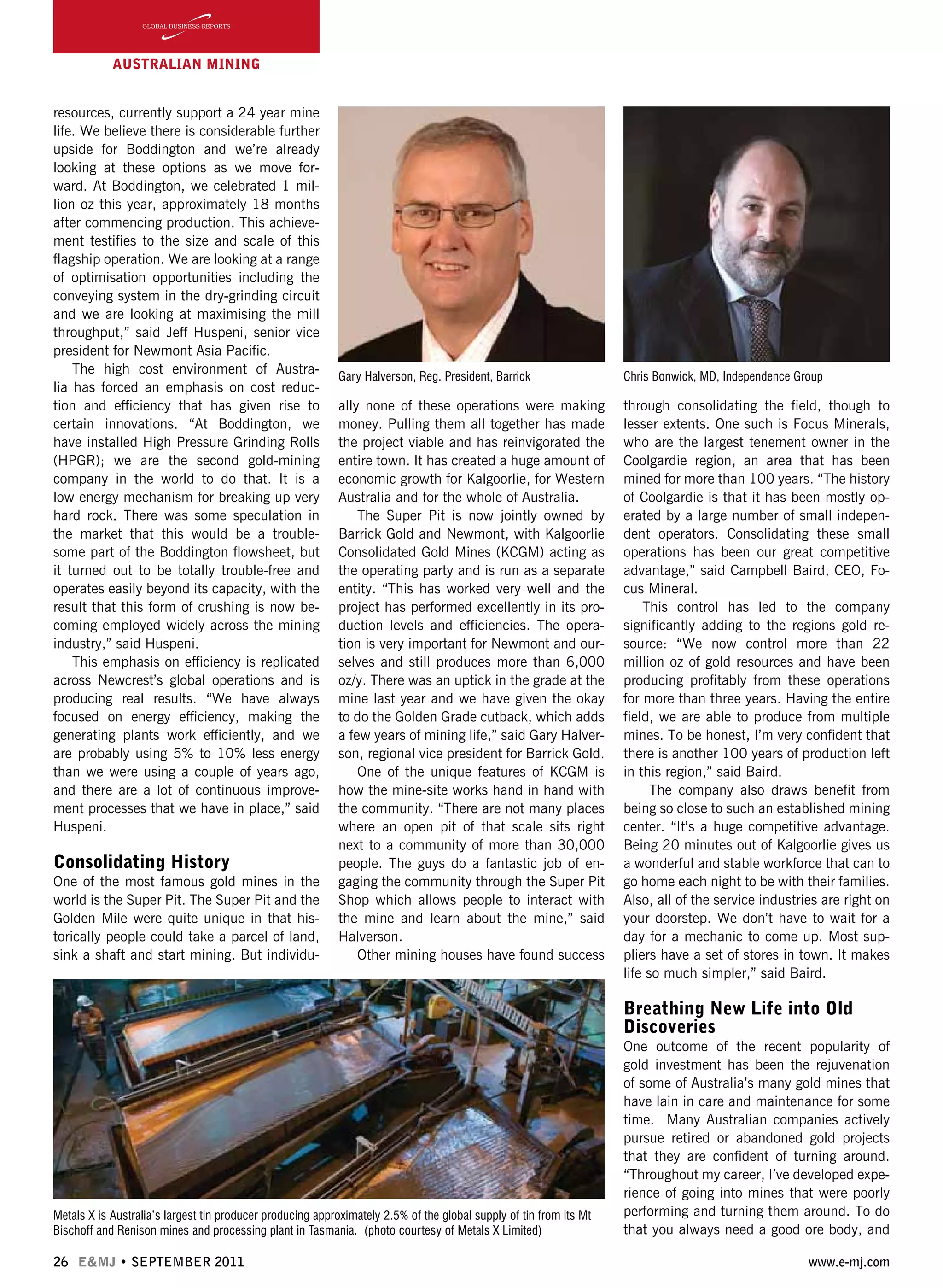


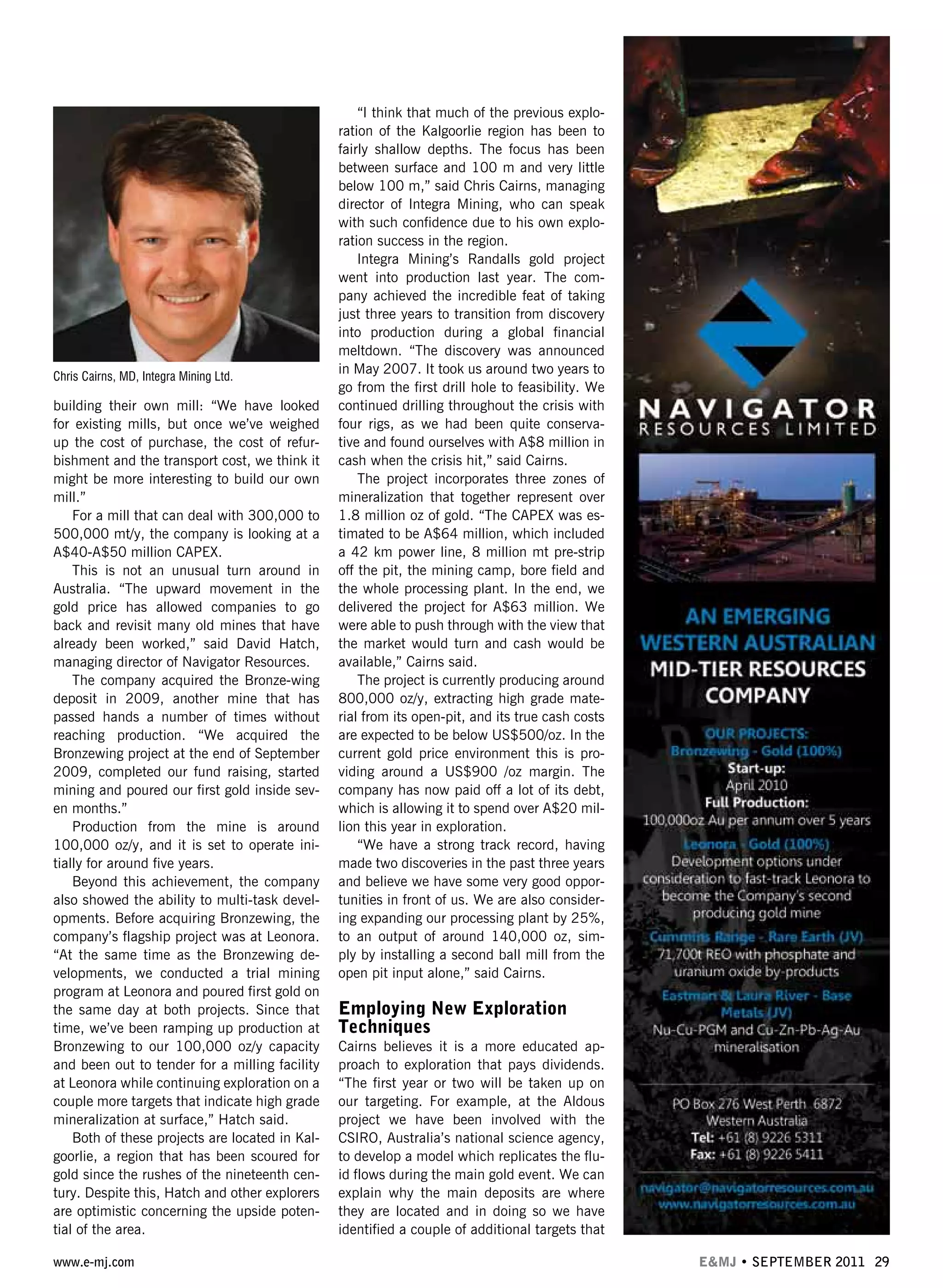


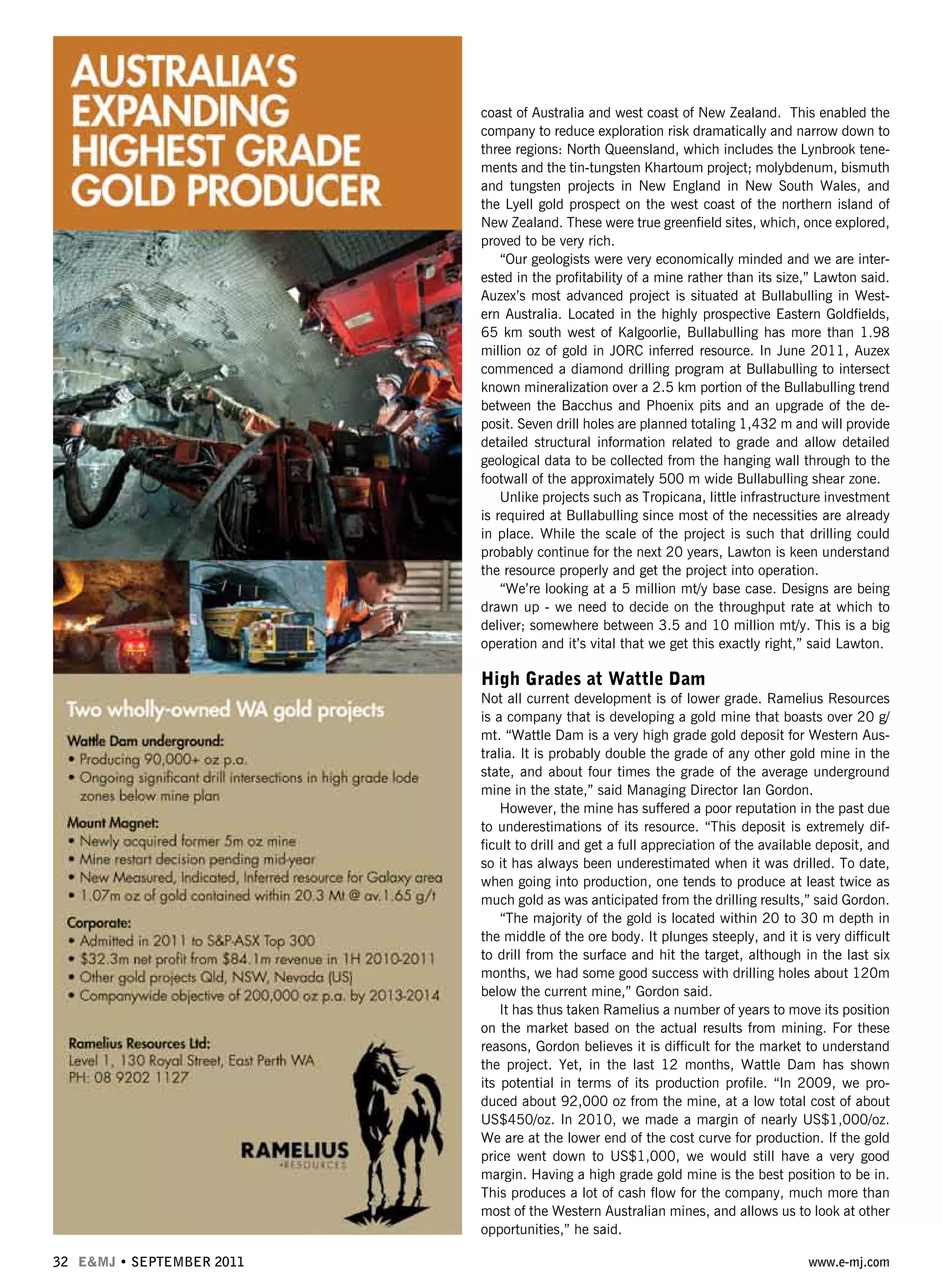
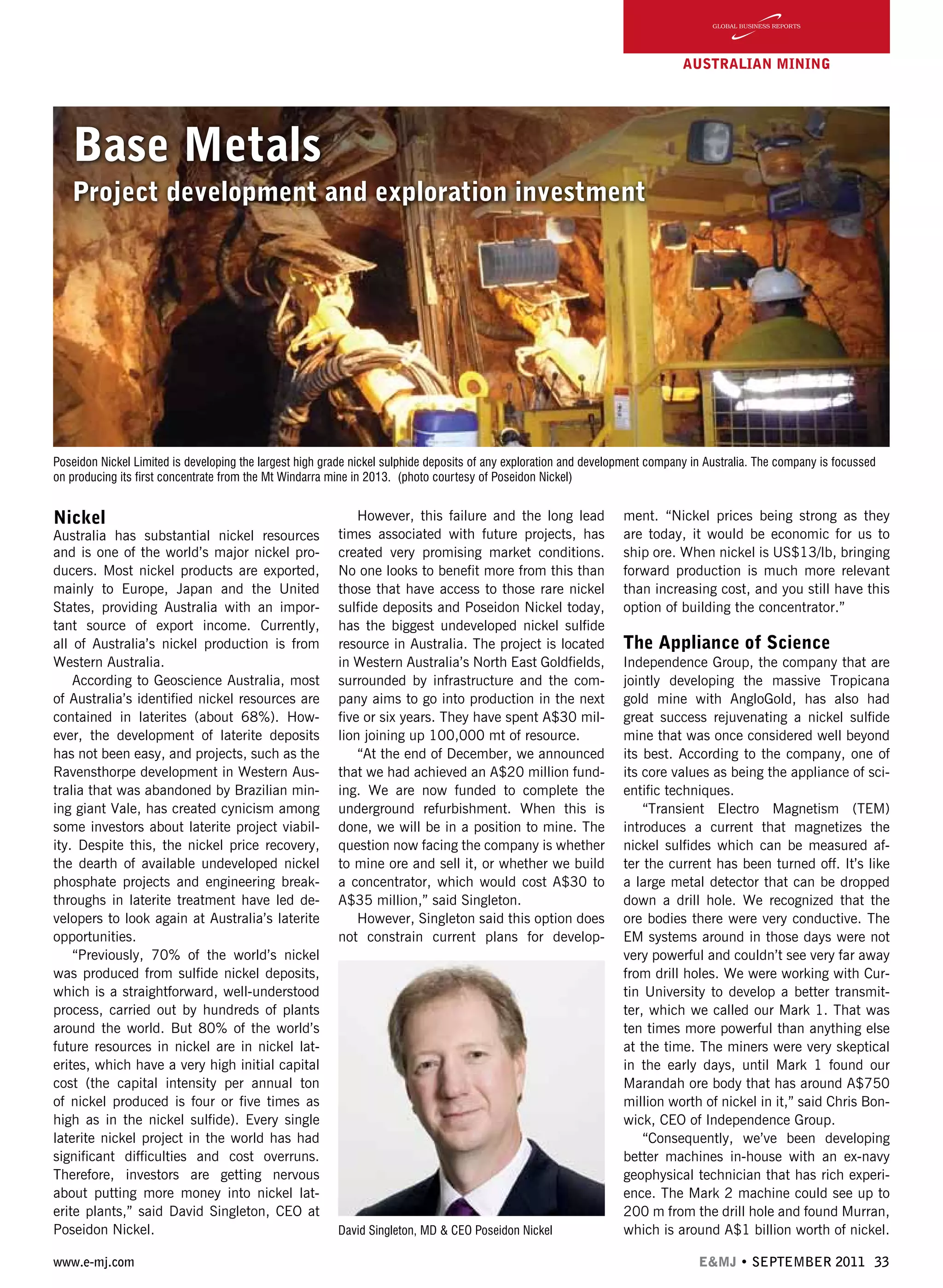
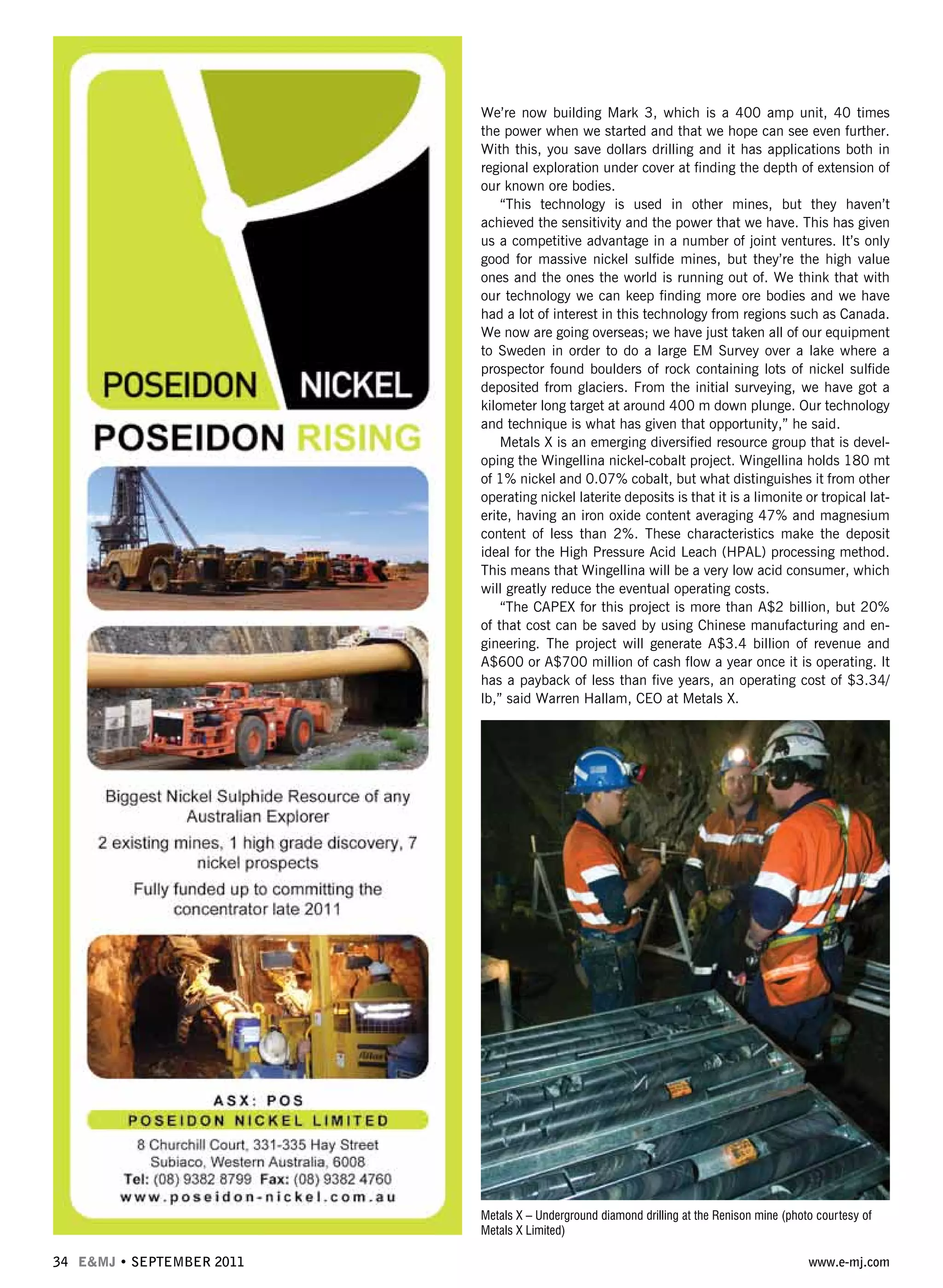



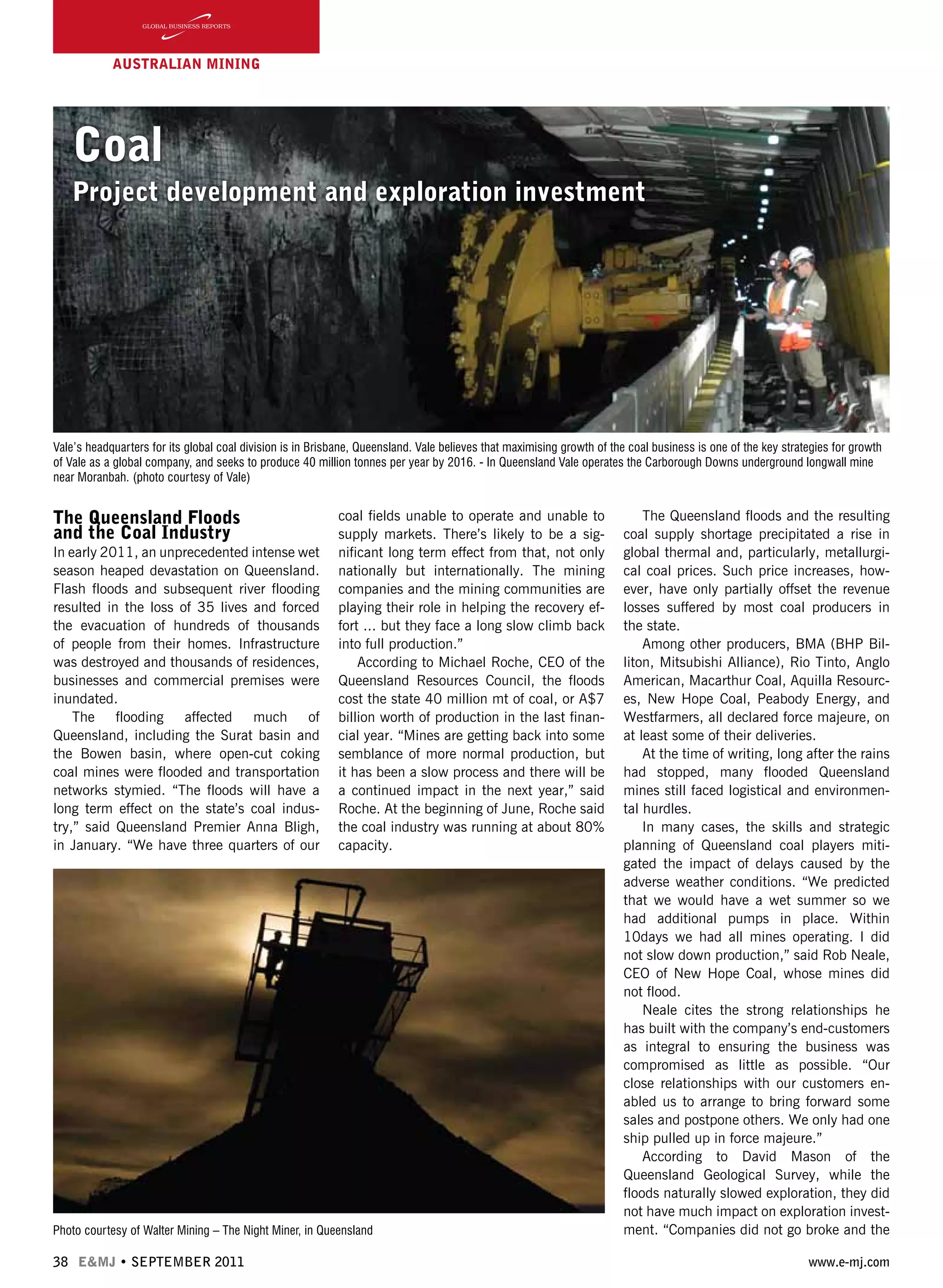

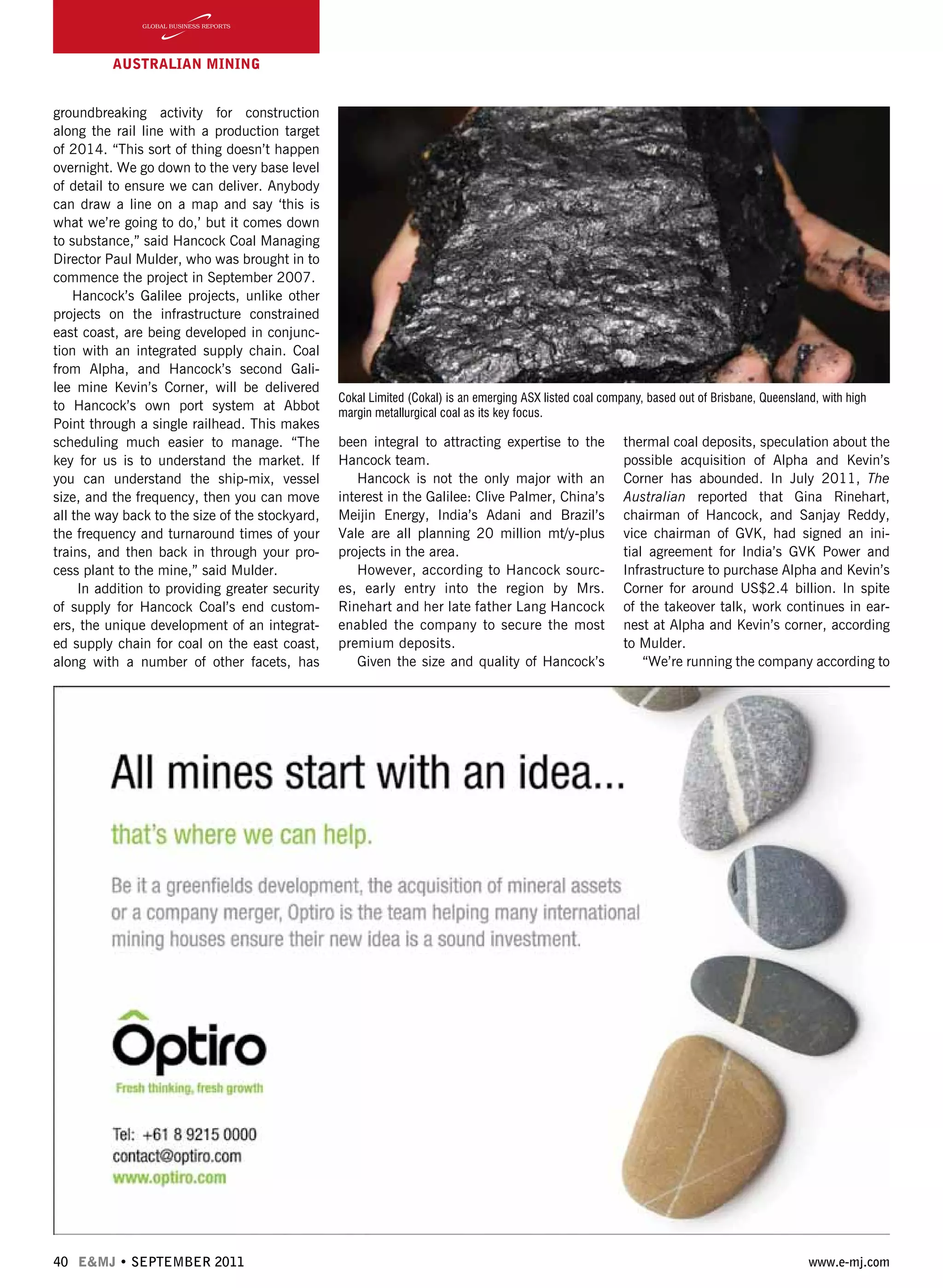
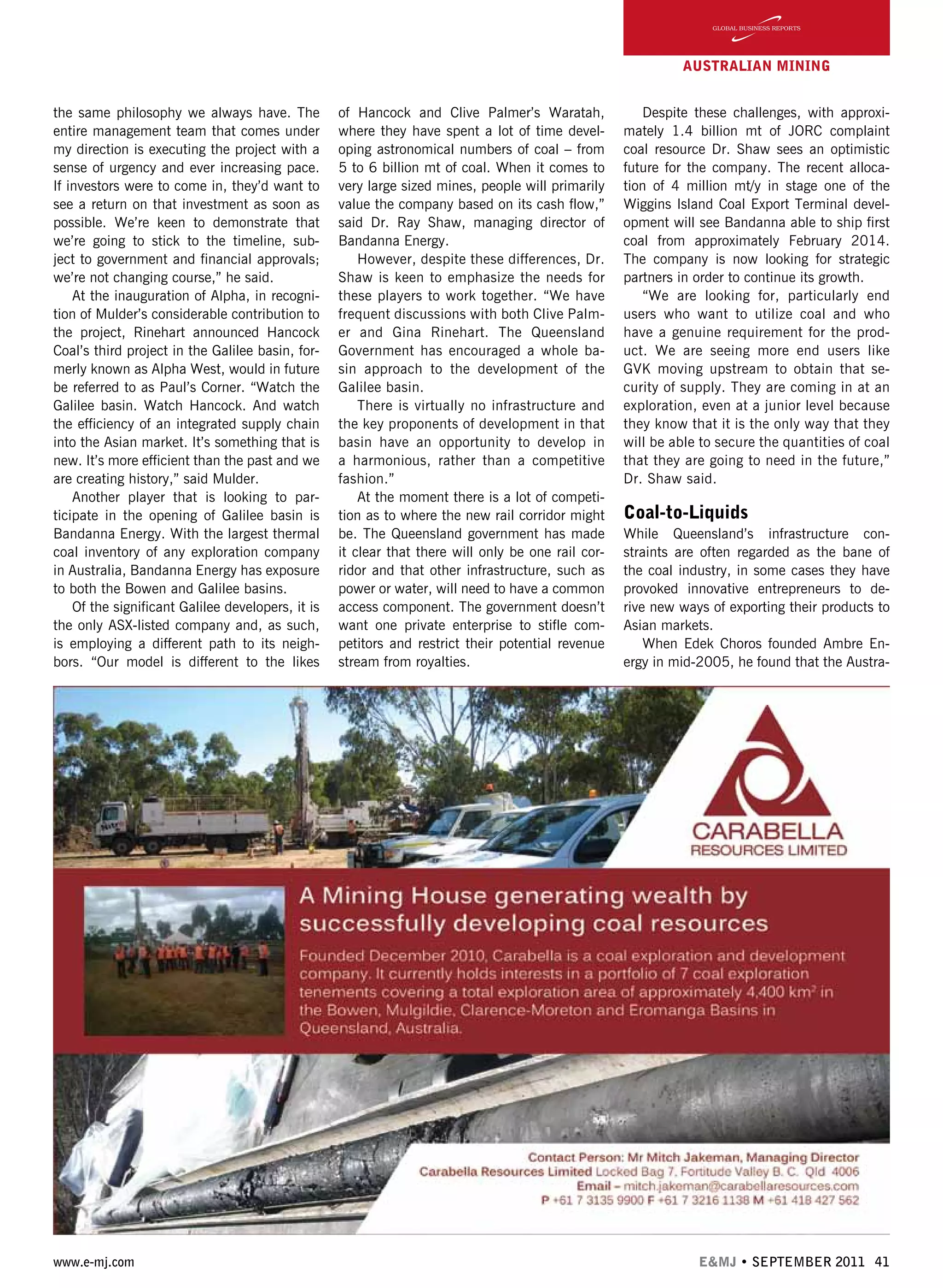

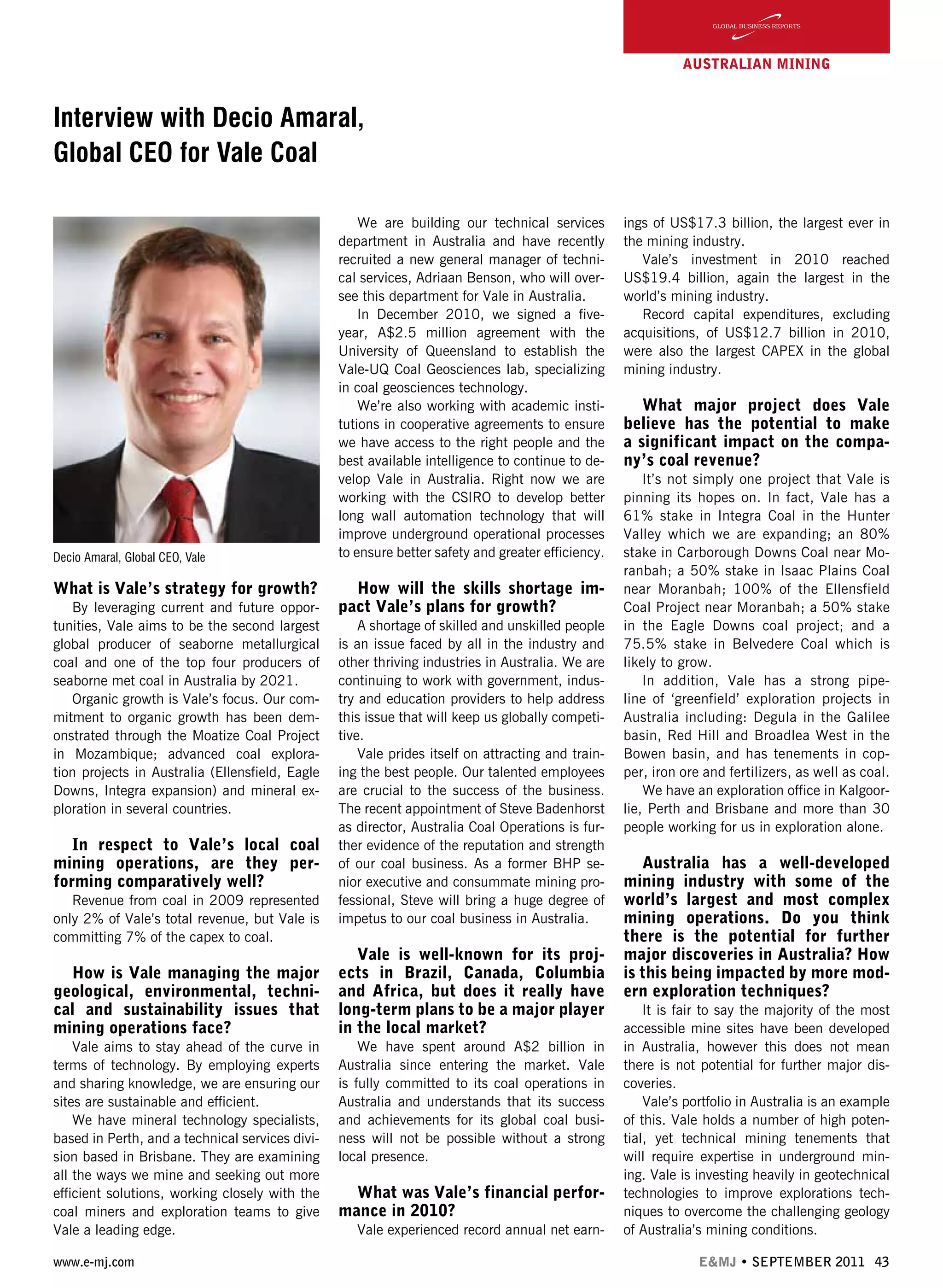

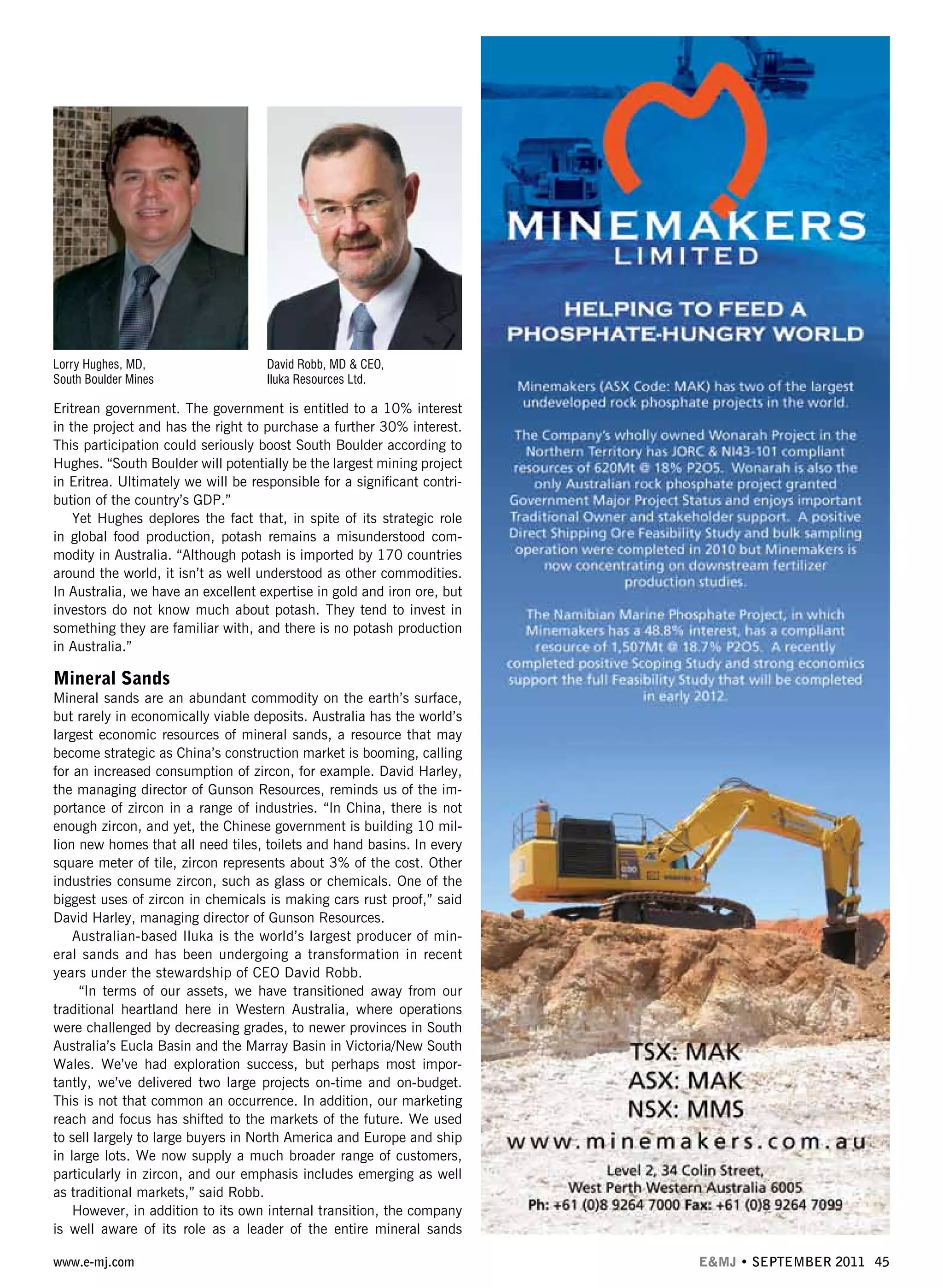
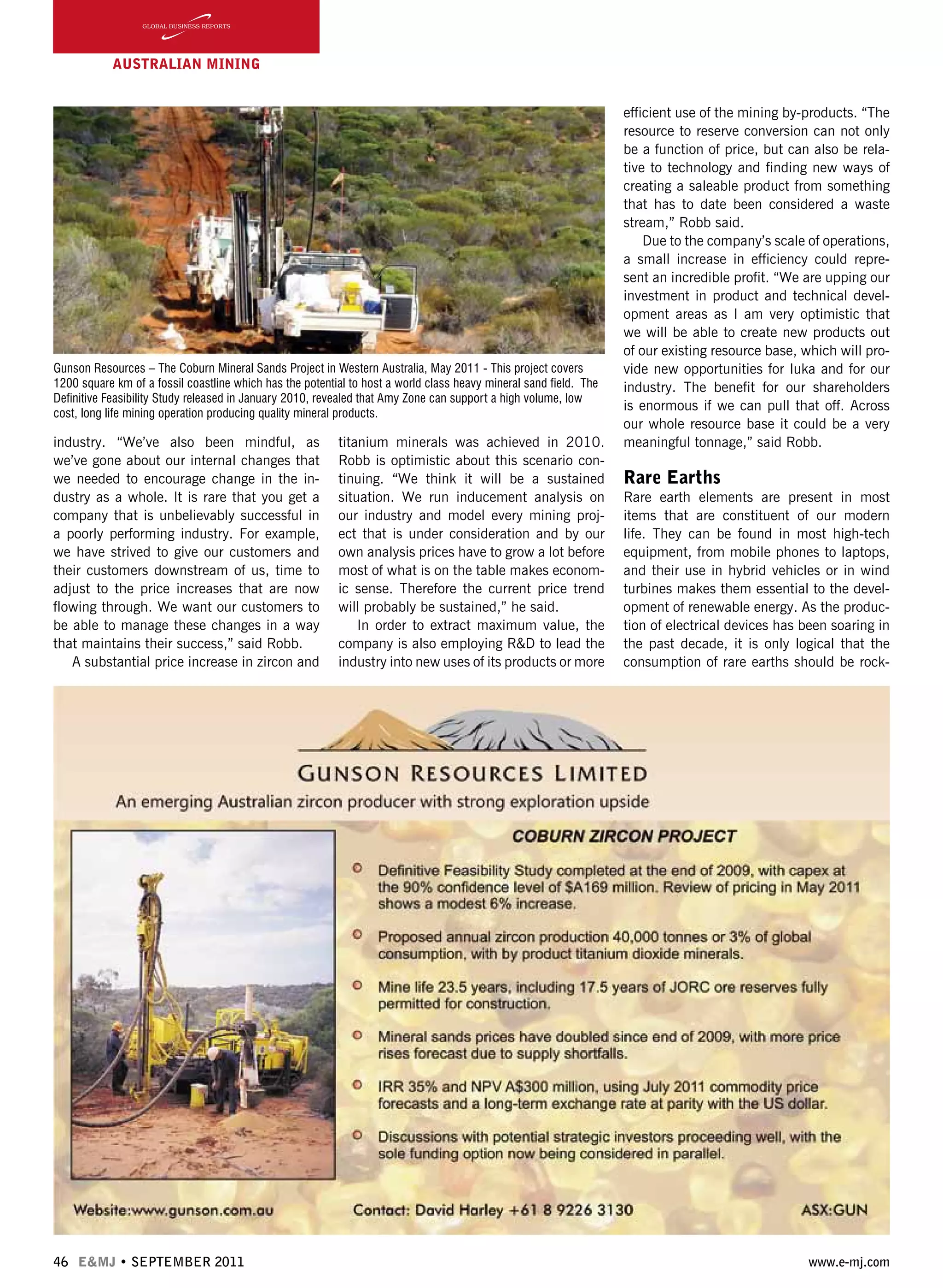
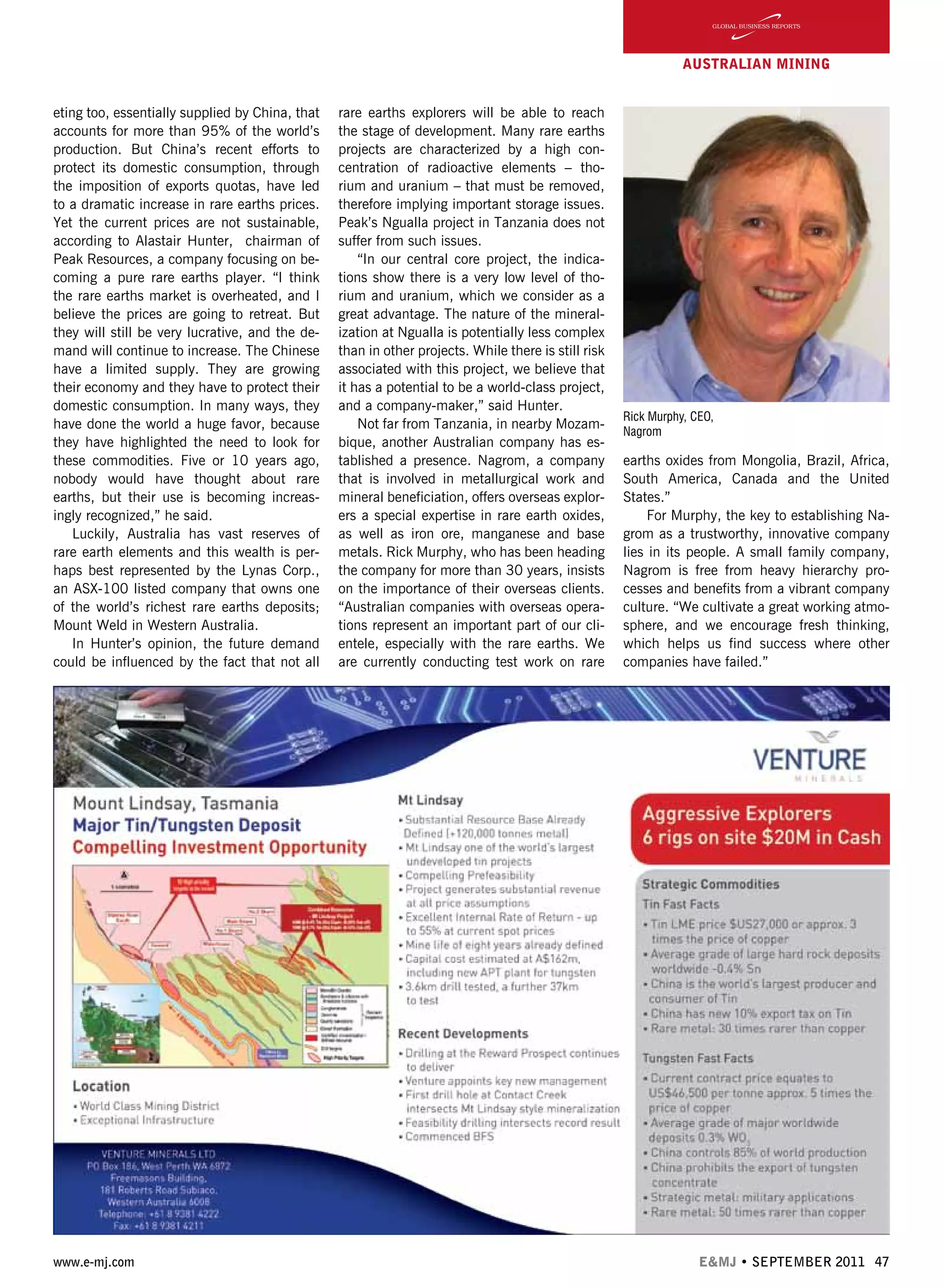
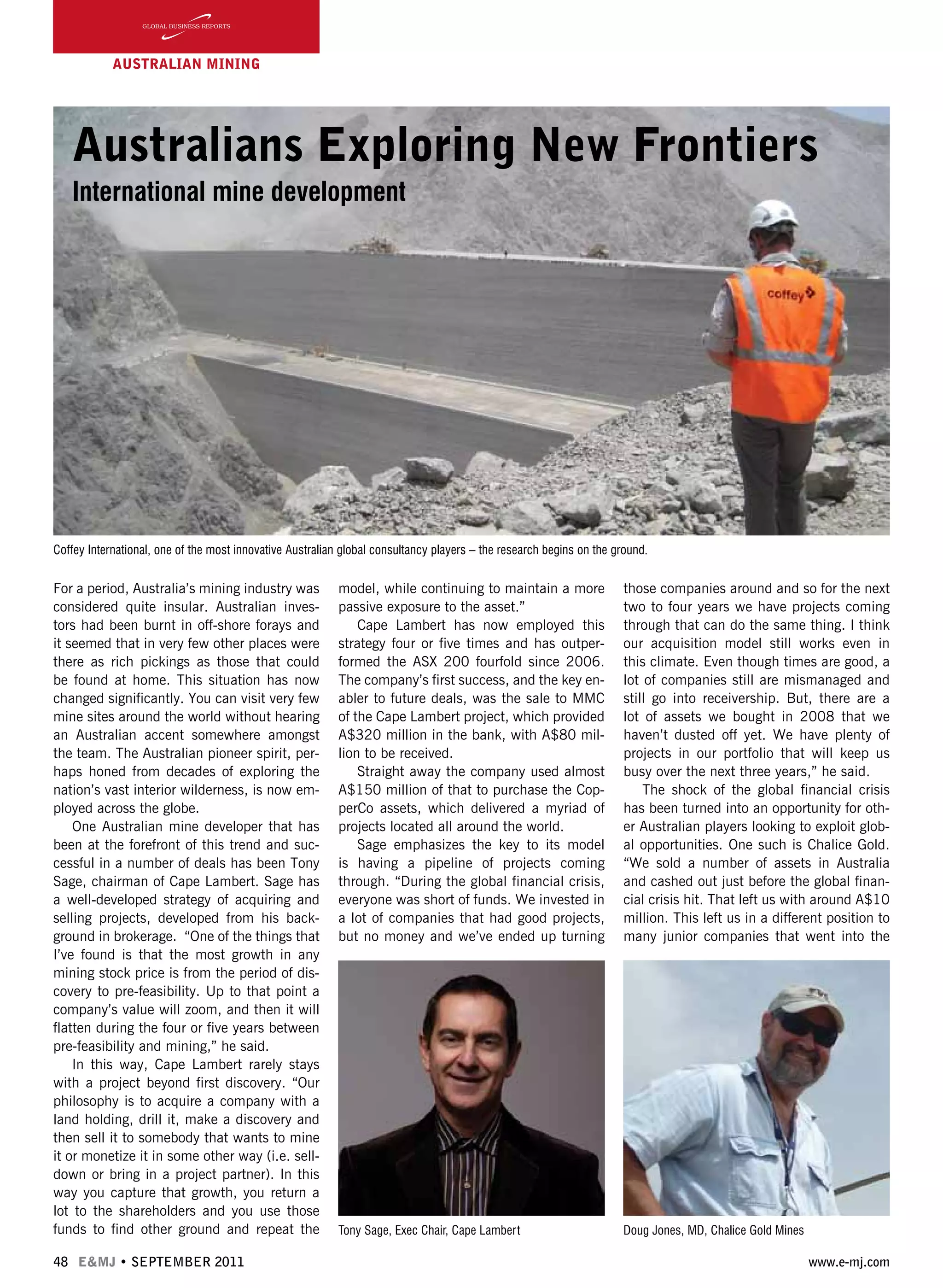

![50 E&MJ • SEPTEMBER 2011 www.e-mj.com
AUSTRALIAN Mining
Korea, China, Indonesia, India and Austra-
lia,” Hughes said.
West Africa
One has limited chances of finding Dr. Paul
Kitto in his Perth office in order to pay him
an unexpected visit. The former Africa explo-
ration manager for Gold Fields Ltd, who is
now heading Ampella Mining Ltd, makes it a
point to spend as much time as possible on
the field in Burkina Faso, where his projects
are located.
Having lived several years in Africa, Dr.
Kitto joined Ampella as the CEO with the
conviction that he could make a significant
difference to the future of the company.
He has indeed honored his commit-
ments, as he today supervises the prom-
ising Batie West prospect. Dr. Kitto draws
a parallel between Burkina and Western
Australia. “West Africa’s geology is very
similar to Western Australia’s. Although the
geological formations have different ages of
deposition, the Yilgarn in Western Australia
and the Birimian in West Africa are almost
identical in every other respect. All we have
to do is take our West Australian knowledge
and experience and implant it into West Af-
rica,” he said.
As a sign of his confidence that Burkina
Faso has potential for world-class deposits,
Kitto has budgeted A$32 million for explo-
ration in 2011, therefore increasing to 2.2
million oz the resource estimation for the
Konkera prospect within the Batie West gold
project. Kitto hopes that this exiting year will
pave the way for the near future, and antici-
pates having a three mt/y plant, producing
more than 200,000 oz/y of gold from early
2014.
The Batie West project luckily benefits
from an excellent infrastructure, and even
has access to a power grid, which is usu-
ally the biggest issue for mining operations
in West Africa. “In Burkina Faso, and at
Batie in particular, we benefit from good
infrastructure. We have a sealed highway
from the capital to the top of our tenements,
excellent communication networks, and a
stable water supply. There is a major power
grid in Ghana, about 20 km away from us,
and we are investigating potential links to
this grid.”
There are currently six operating gold
mines in Burkina Faso, and each of them
has gone through a fast, efficient approv-
als system. Kitto appreciates the ease with
which it is possible to start a mining op-
eration in the country. “[Burkina Faso] is a
highly prospective country, the government
is pro-mining, and the permitting process,
although very rigorous, is there to assist
companies to go forward. Resource Stocks
ranked Burkina Faso sixth out of 52 African
countries on a social and political scale. Re-
cently the Fraser Institute released a survey
about exploration potential world-wide and
Burkina Faso was listed among the top six
countries in the world in which to explore.
The country has a good social and political
environment, and great prospectivity related
to its mineral wealth. The mining future for
Burkina Faso looks very good indeed.”
Wayne Norris, managing director of ju-
nior Noble Mineral Resources, displays a
similarly communicable enthusiasm towards
Ghana, where his flagship Bibiani project is
located. “In terms of prospectivity, Ghana
is like Kalgoorlie a 100 years ago. Bibiani
is exemplary of those deposits that are very
exciting with today’s gold prices.”
Australian, North American and Europe-
an companies started entering the country in
the eighties, and are today enjoying the full
support of the Ghanaian authorities. Noble
Mineral’s Bibiani project, that has a current
JORC-compliant mineral inventory of 2 mil-
lion oz of resources, is due to begin produc-
tion in September, and targeting a 150,000
oz/y production by 2012.
Central Arica
Central Africa contains some of the most
challenging jurisdictions in the world.
However, Australian mining companies
have been operating in this troubled region
for more than a decade and a number of
mine developers have achieved great suc-
cess in Central Africa’s incredibly resource
rich mineral belts.
One such company is Tiger Resources,
a producing copper/cobalt company with a
portfolio of projects in the Democratic Re-
public of Congo’s Katanga copper belt. The
company began producing at their flagship
Kipoi project in April 2011 and will have an
annual production of 35,000 mt of copper.
“Kipoi currently holds 841,000 mt of
Dr. Paul Kitto, MD & CEO, Ampella Mining](https://image.slidesharecdn.com/28c63d64-5f49-4b1f-829f-d9d98c27c114-160115062504/75/Australia_Mining-2011-50-2048.jpg)


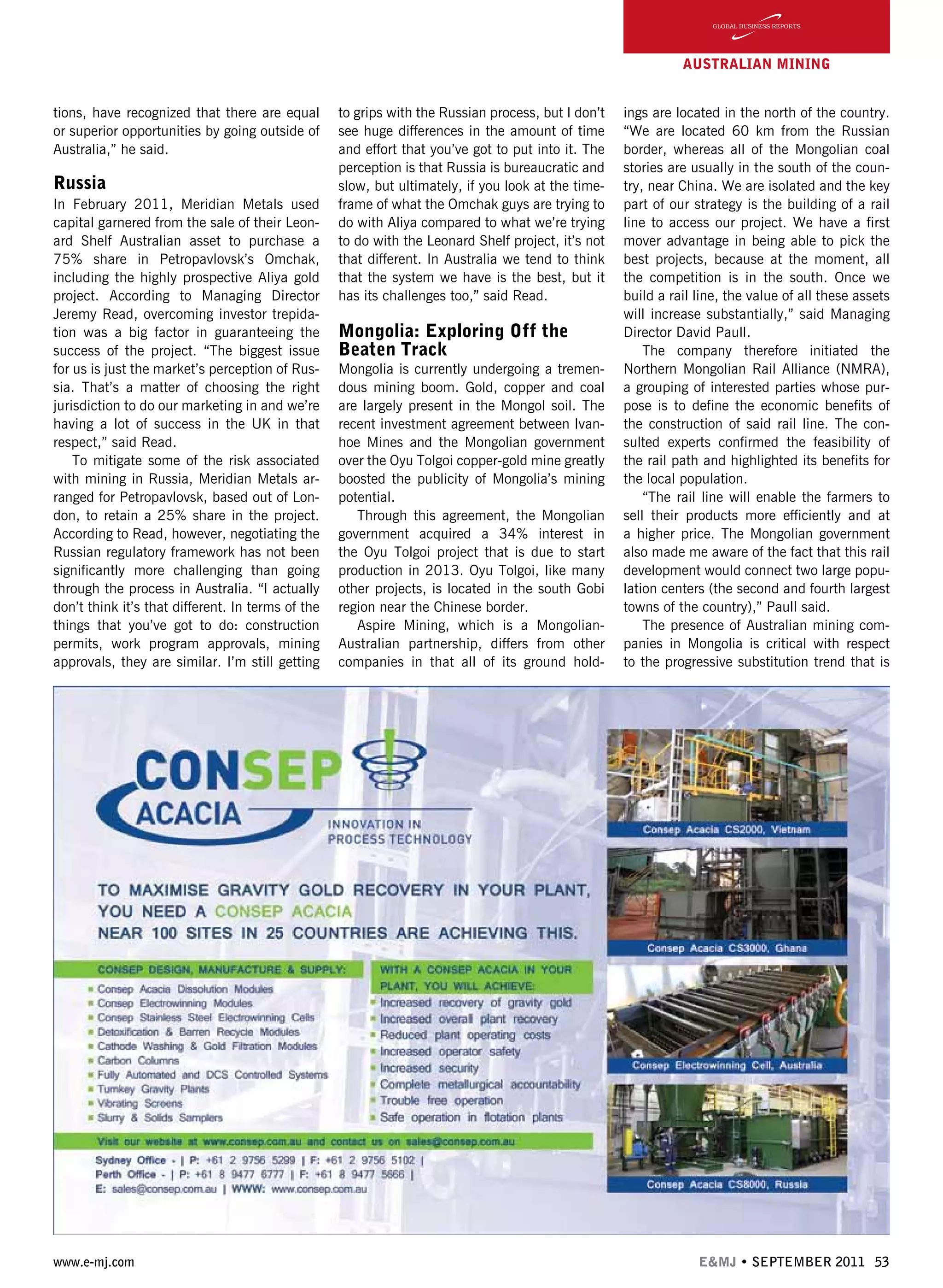

![www.e-mj.com E&MJ • SEPTEMBER 2011 55
AUSTRALIAN Mining
wealth of this nation.” It is Australia’s infra-
structural constraints, at least in part, that
have led to one pioneering Australian junior
turning its attention to Indonesia, Australia’s
greatest competitor in the supply of coal to
Asian markets. When Peter Lynch left Wara-
tah Coal in 2010, he began investigating
opportunities in the coal space in Austra-
lia, however realizing much of the premium
ground had already been pegged, Lynch,
with his company Cokal, decided to look for
lower hanging fruit overseas. By the end of
June 2011, Cokal had confirmed high qual-
ity premium metallurgical coal at its Bumi
Barito Mineral (BBM) project, a site cover-
ing approximately 20,000 ha in the Indone-
sian territory of Central Kallimantan. “This
company is now ahead of the game and
therefore offers investors a significant oppor-
tunity, while our competitors are falling over
each other trying to get coal to Australian
ports at horrendous cost,” said Lynch.
Cokal is increasing drilling capacity at
BBM to provide a coal resource estimate
by the end of the third quarter of this year,
according to CEO Jim Middleton. “Central
Kalimantan is a brand new region, with
only one other producer at present. It could
contain up to 10 billion mt, making it the
third largest seaborne trading coal basin in
the world.”
When we interviewed him in June 2011,
Lynch was bullish about the possibilities for
Kalimantan. “In four to five years’ time, we
could be producing more than 5 million mt/y
of metallurgical coal - that would make us a
A$6 billion company - and could then grow
even bigger.”
The notion of exchanging exploration risk
for political risk often prefaces discussions of
Australian explorers who venture beyond the
red earth of Western Australia or the brown
basins of Queensland. According to Lynch,
the scales are no longer balanced in favor
of Australia. “I found some very attractive
assets in Indonesia, a country whose risk
profile, while not perfect, had improved dra-
matically in the same time that Australia’s
had worsened.” To further mitigate what
Lynch perceives as an already significantly
reduced risk profile, Cokal is engaged in ex-
ploration activities through joint ventures in
Mozambique and Tanzania.
In relation to lagging infrastructure in
Australia’s coal provinces, Indonesia pres-
ents rich pickings. “Operating costs [at
Kalimantan] are very competitive with the
Bowen basin. The site is around 500 km
from the mouth of the river by barge, with
the cost of this transportation at A$14/mt
- cheaper than a train journey from Gordon-
stone to Gladstone - in addition to A$3-4
trans-shipping costs. Although there are still
initial mining approval procedures, resolving
downstream infrastructure difficulties is far
simpler. To implement additional capac-
ity, you simply have to phone up one of the
barge companies and set up a contract with
them, with no lead time,” said Lynch.
When production ramps up, BBM will
benefit from significantly reduced mining
costs. Indonesian fuel and labor costs are
significantly cheaper than in Australia and
the coal seams at Kalimantan are all out-
cropping, in contrast to most in Australia
that are sub-cropping under around twenty
meters of cover.
Community Engagement
Away from Home
In terms of community uplift, mining can be
something of a paradox. The establishment
of a mining project in a remote jurisdiction
can bring jobs, training, education and eco-
nomic flow-on to a community otherwise
estranged from the material benefits of big
business. Australia’s PanAust, for example,
through its Phu-Kham copper-gold opera-
tion, has made a massive contribution to the
Laos’s economy, investing around US$700
million and accounting for approximately
10% of the nation’s estimated GDP. When
PanAust’s silver-gold project Ban Houayxai
comes into production in 2012, the contri-
bution could be even greater. On the other
side, however, mining can pose a threat to
local flora and fauna, displace residents,
create wealth inequalities and disrupt tradi-
tional livelihoods and culture. “In central Ka-
limantan there is not great access to things
that we take for granted, such as education,
health and infrastructure,” said Lynch. “Our
company is heavily involved in training the
local communities in mining, as opposed
to bringing in people from Java, which may
have been easier. We certainly do not intend
to bring in Australian contractors. We are all
about providing employment and economic
opportunity to the locals.”
Peter Lynch, Executive Chairman, COKAL](https://image.slidesharecdn.com/28c63d64-5f49-4b1f-829f-d9d98c27c114-160115062504/75/Australia_Mining-2011-55-2048.jpg)

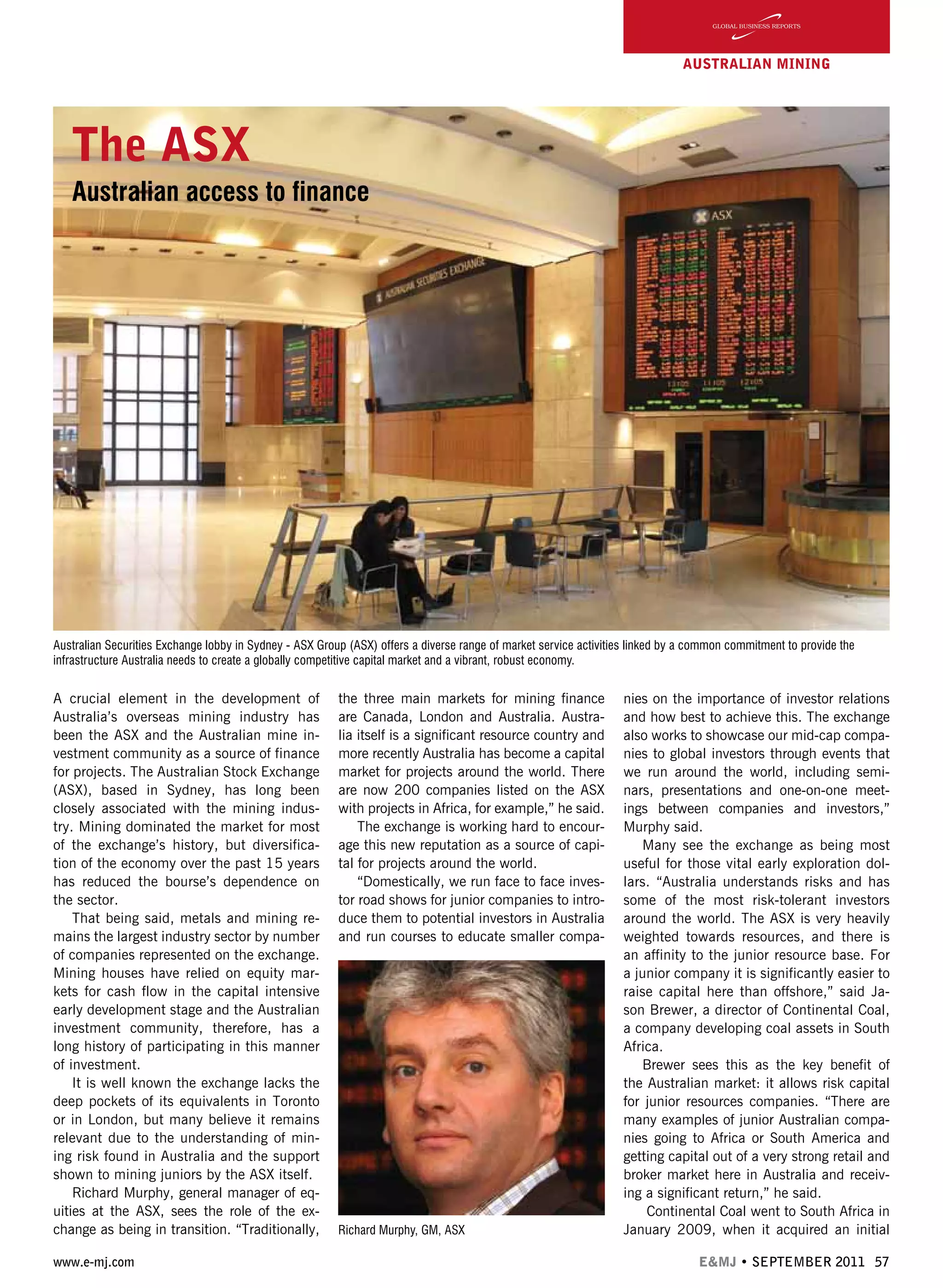
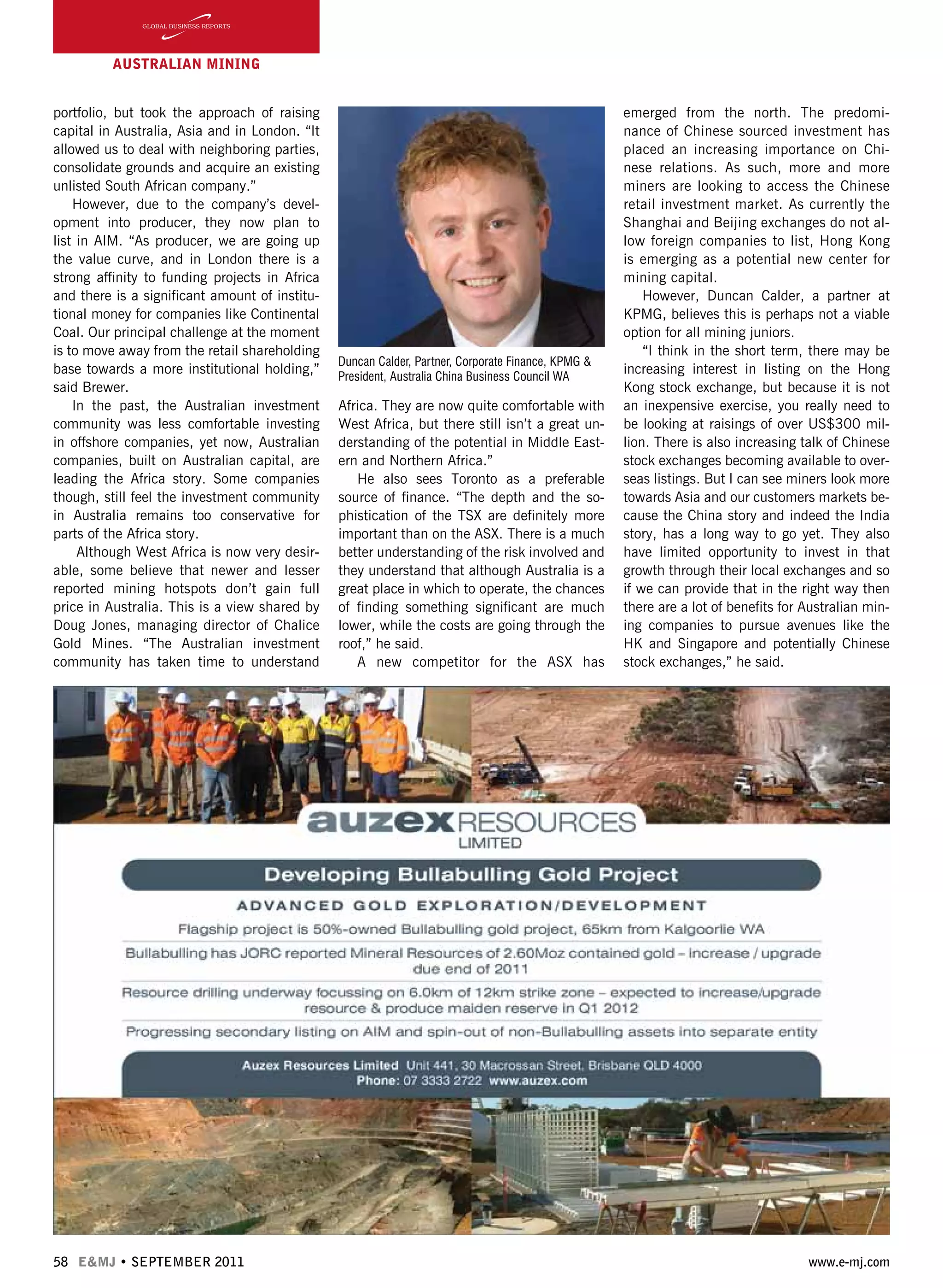

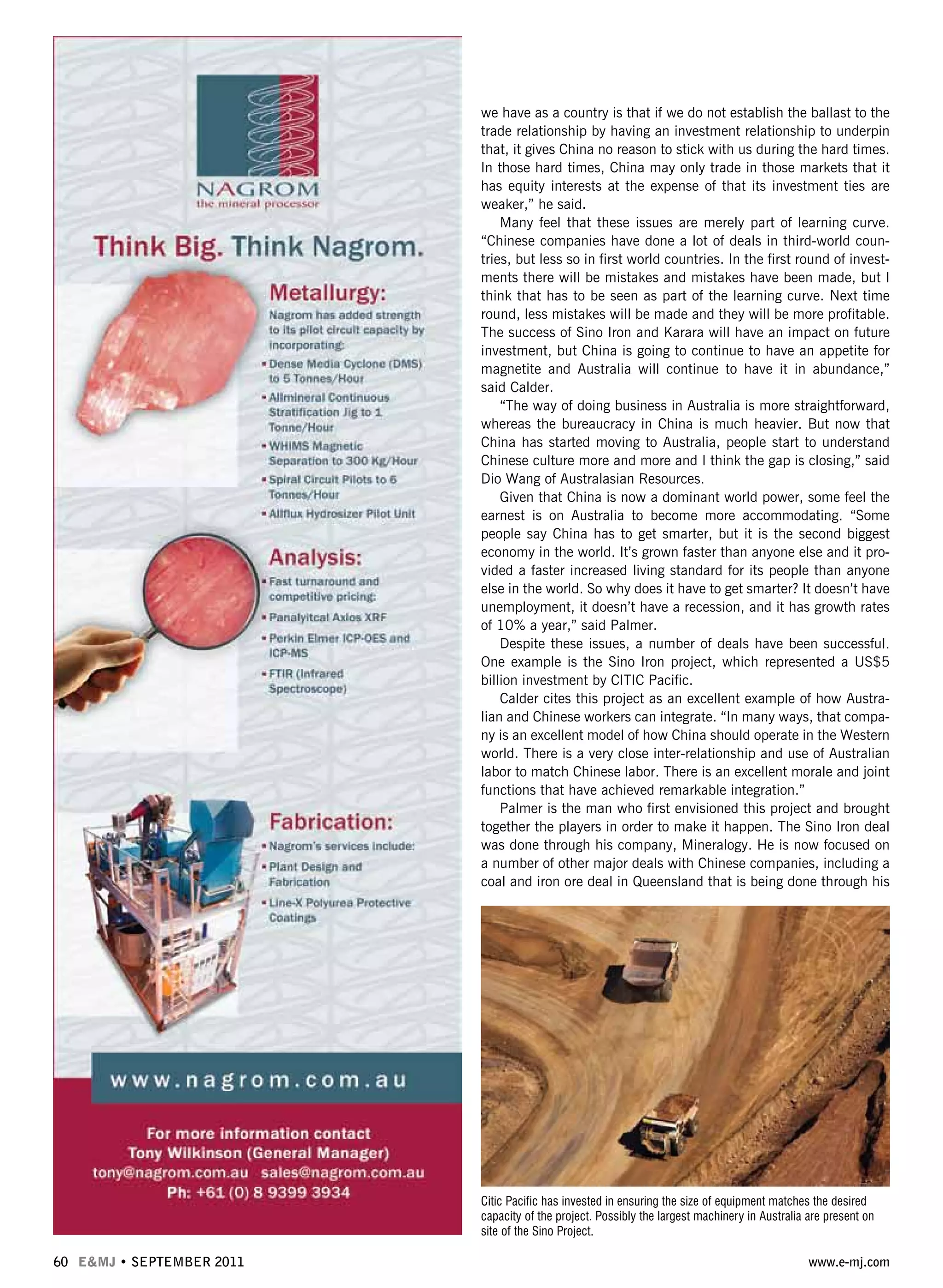


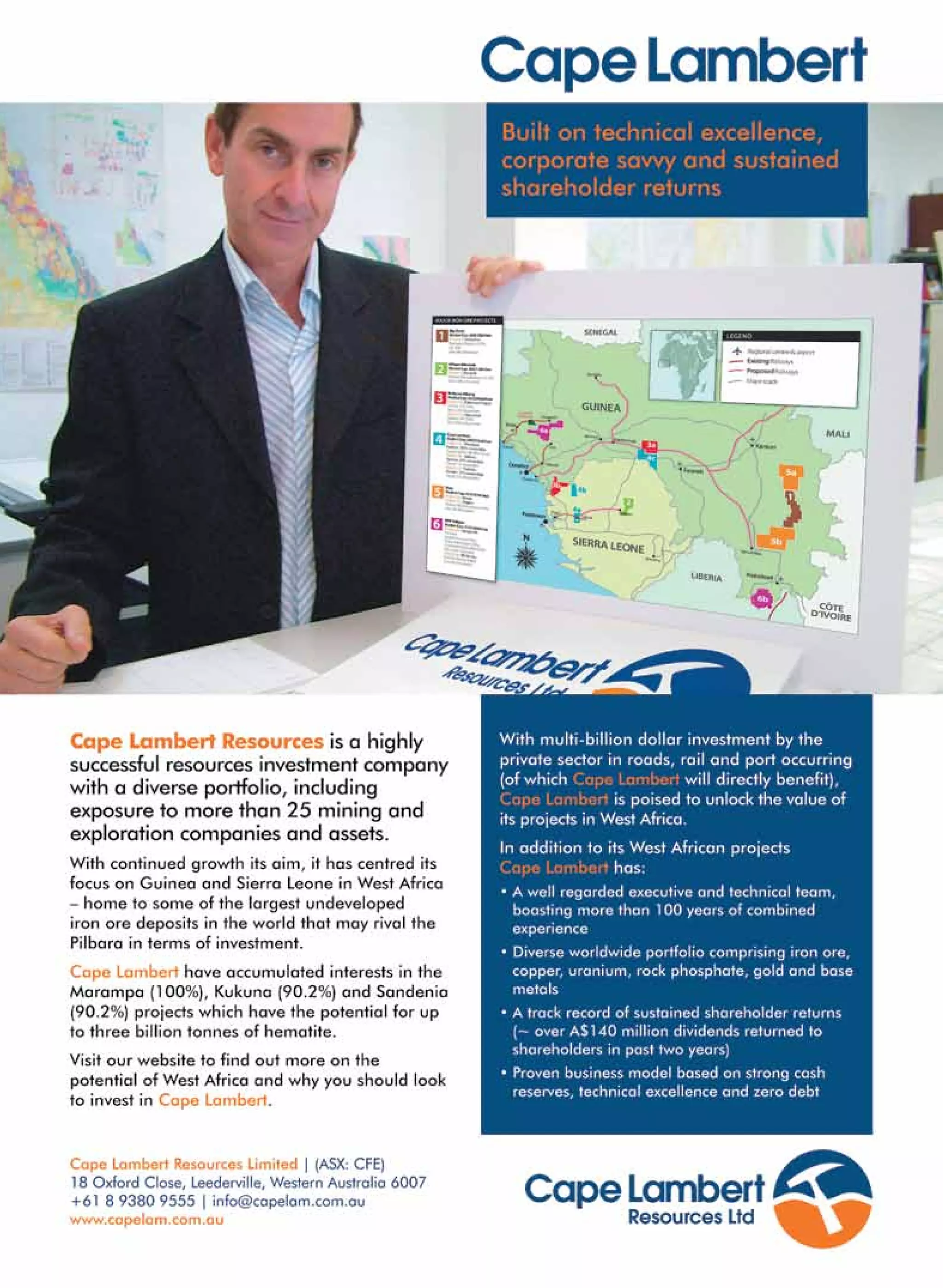


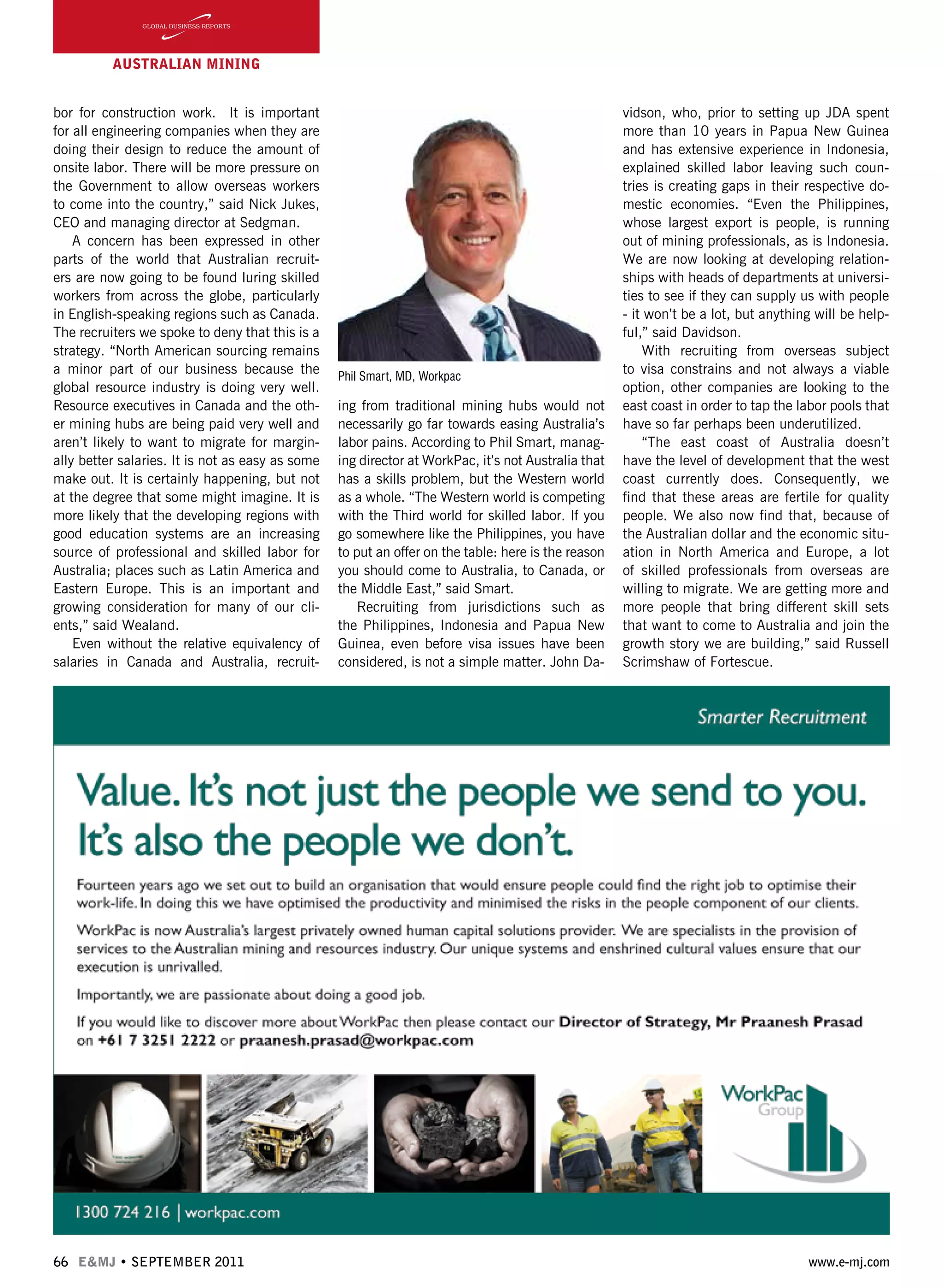
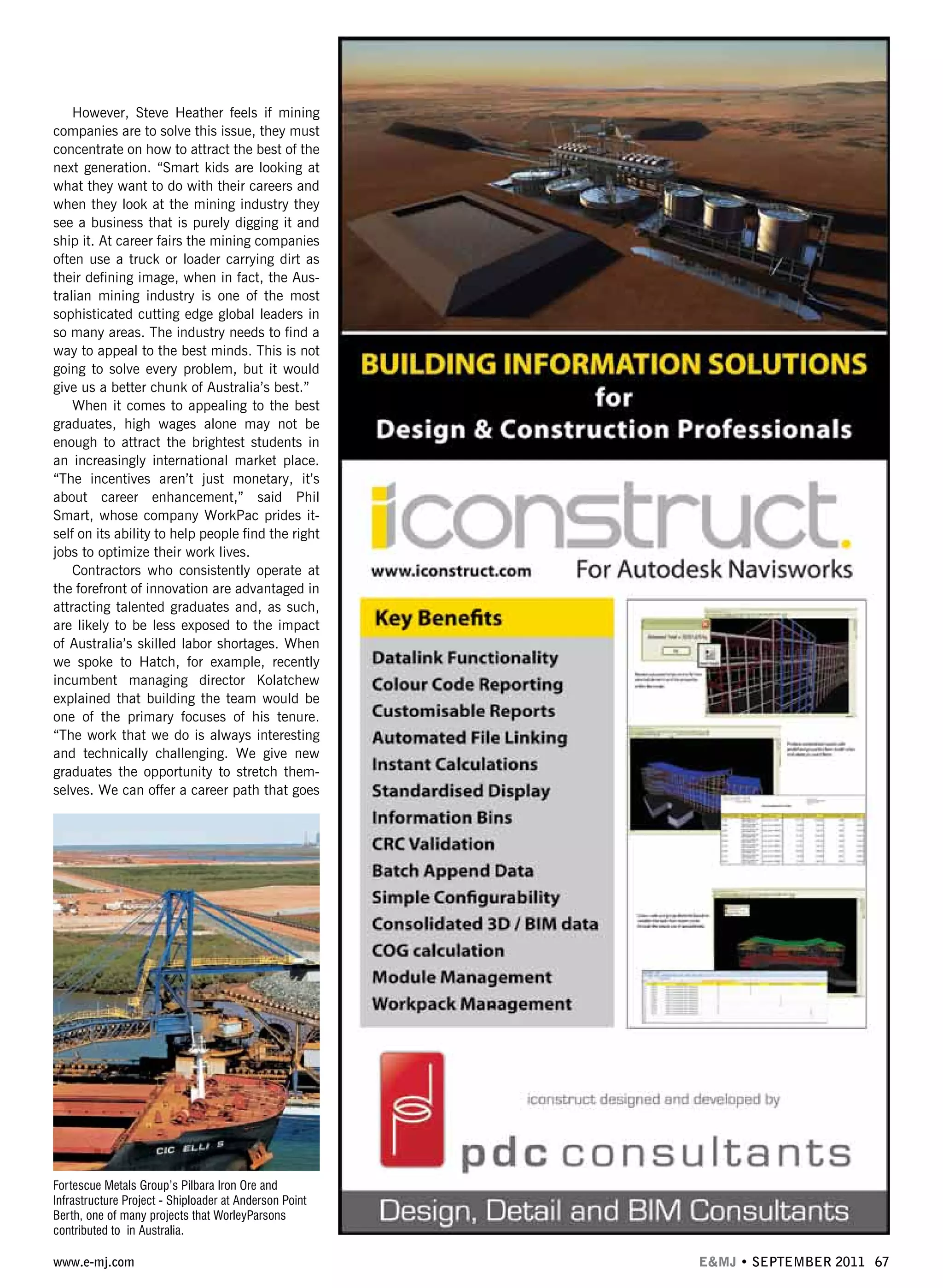
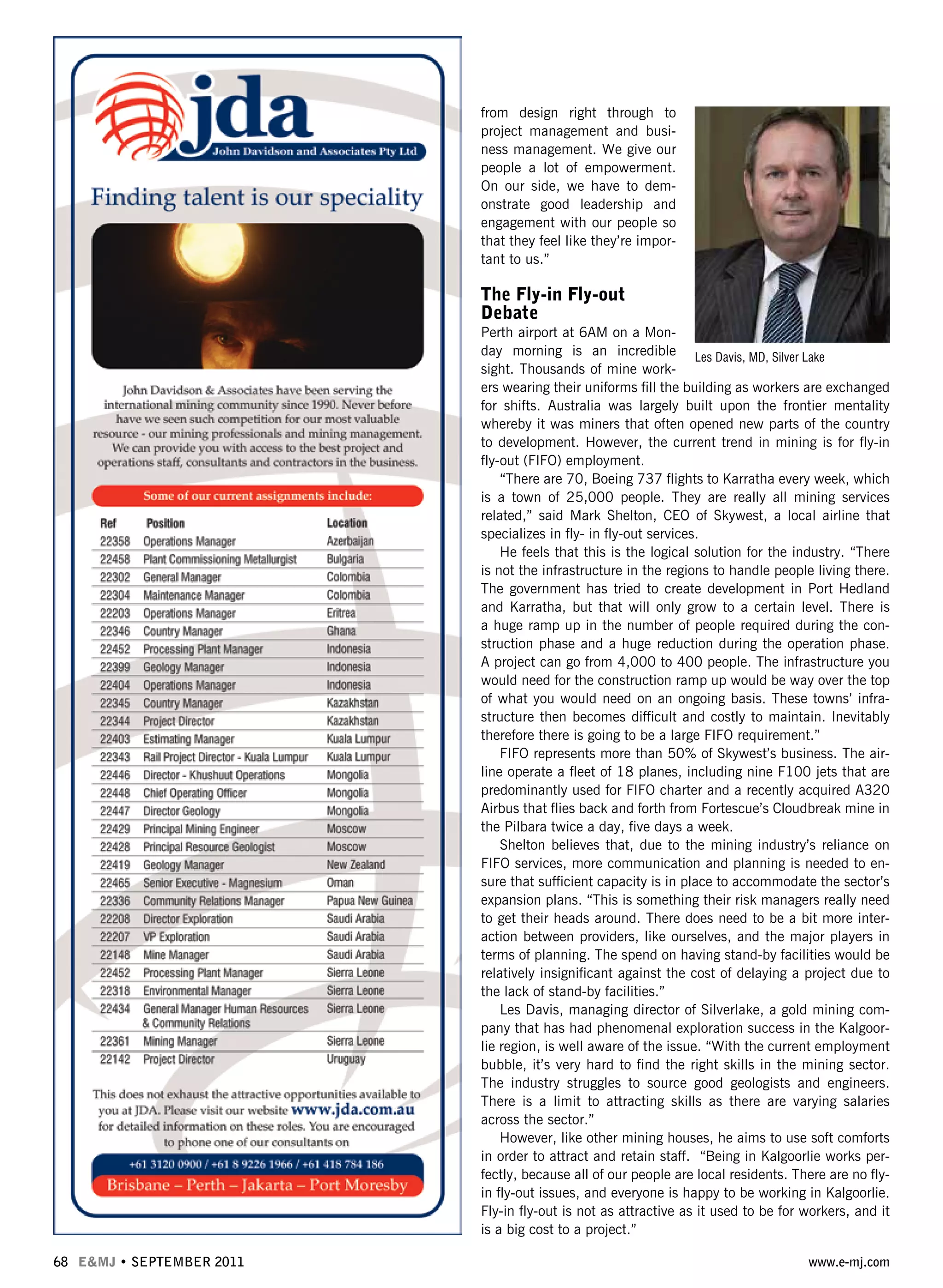
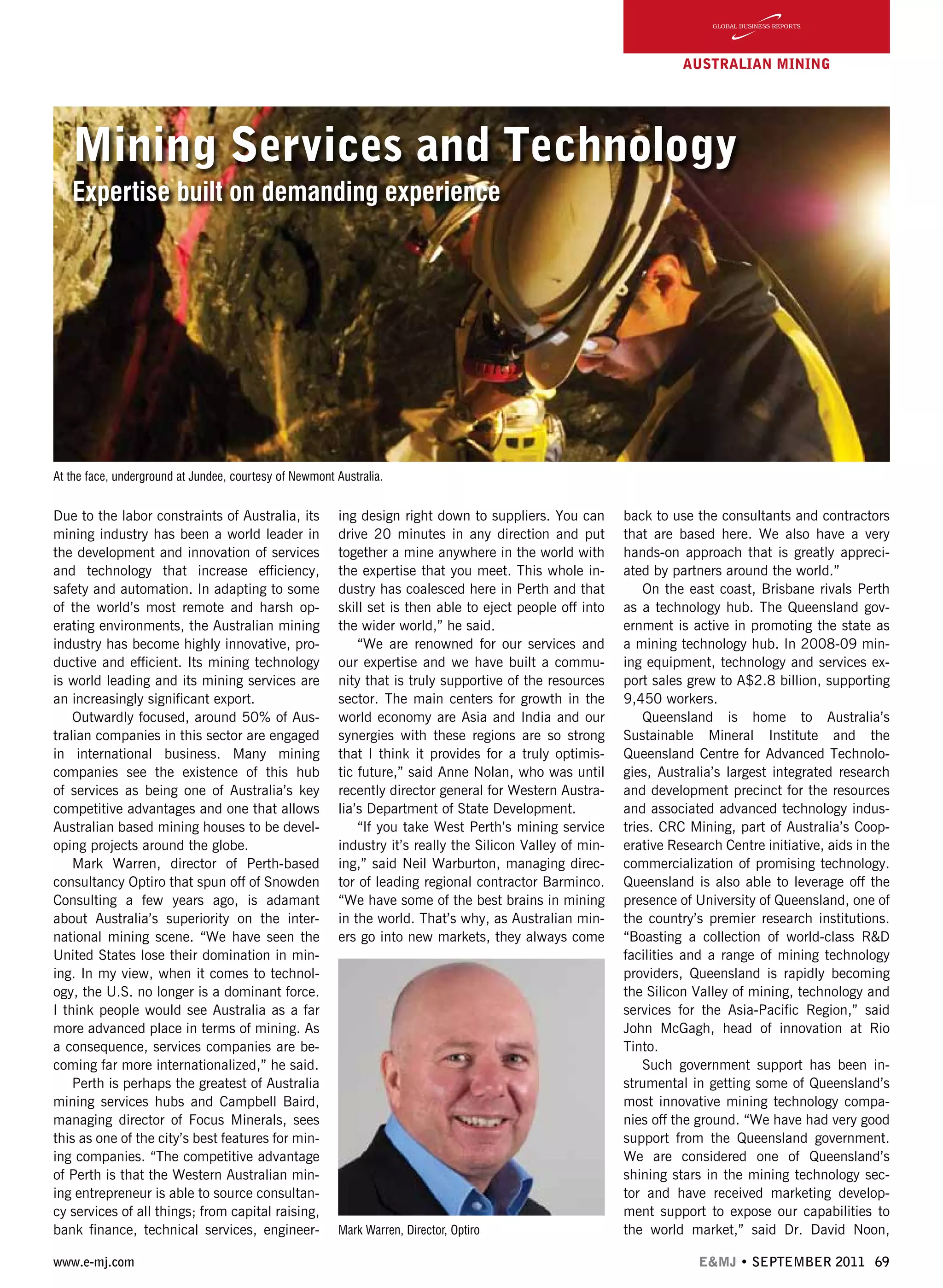

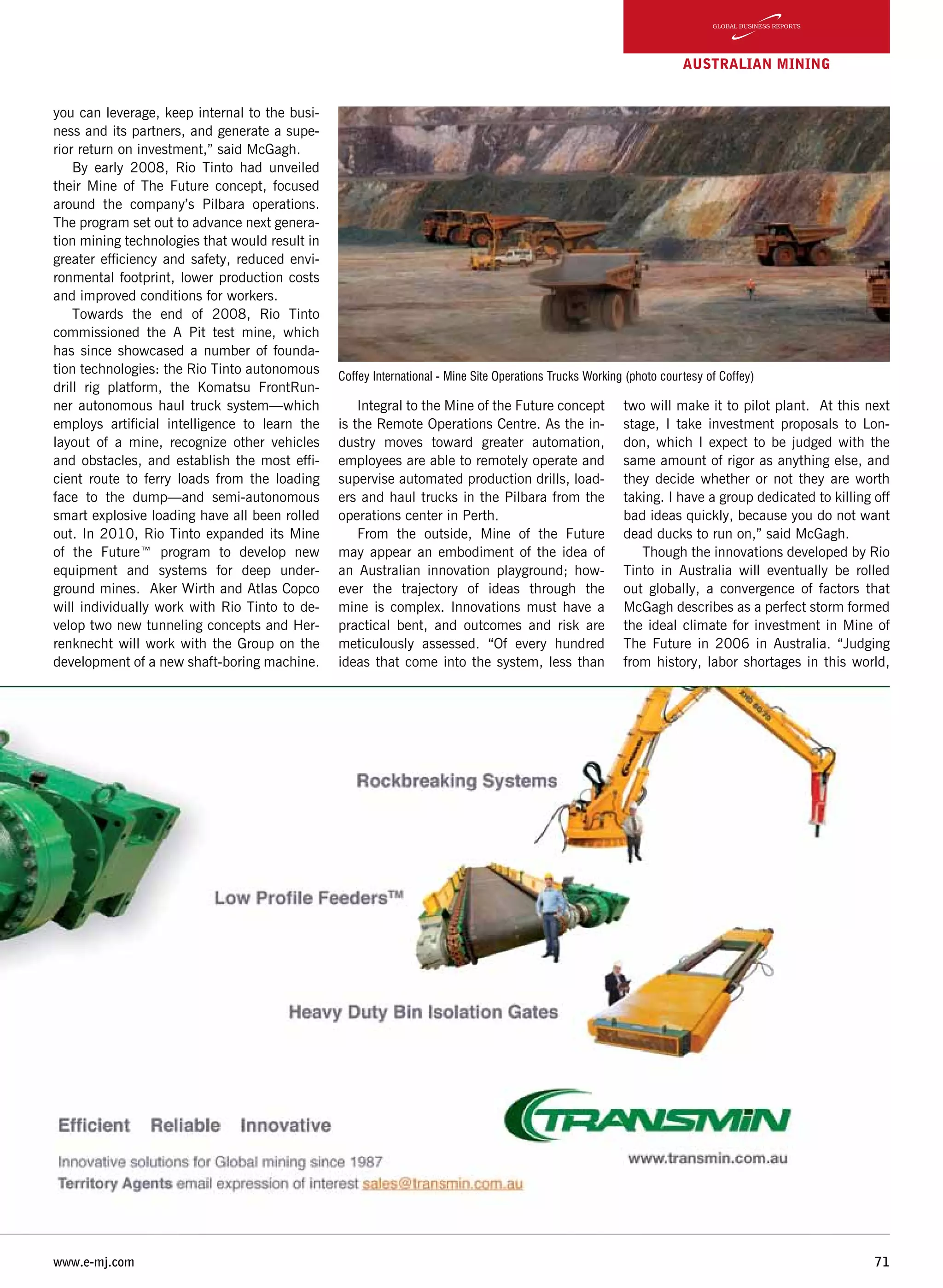
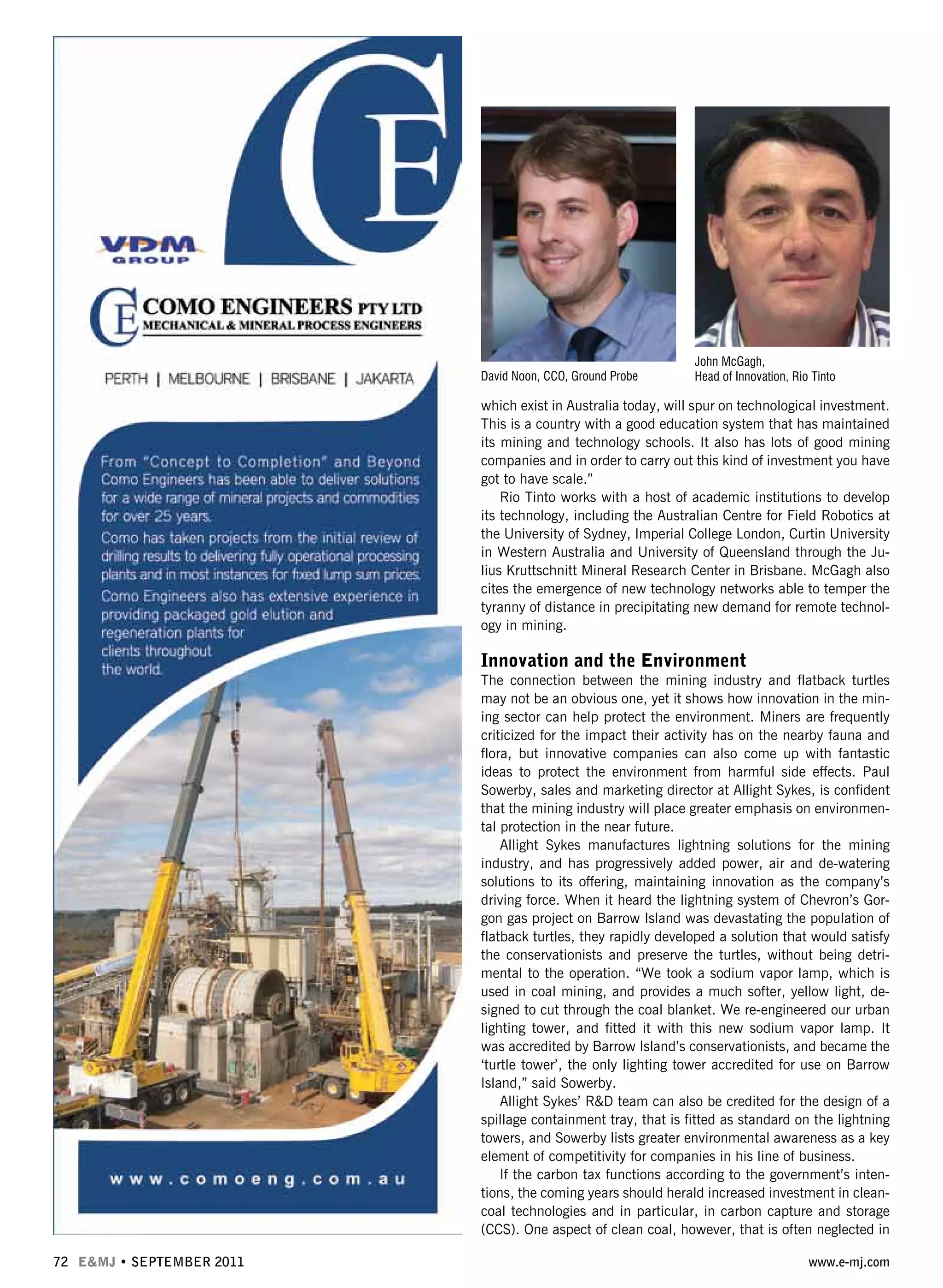

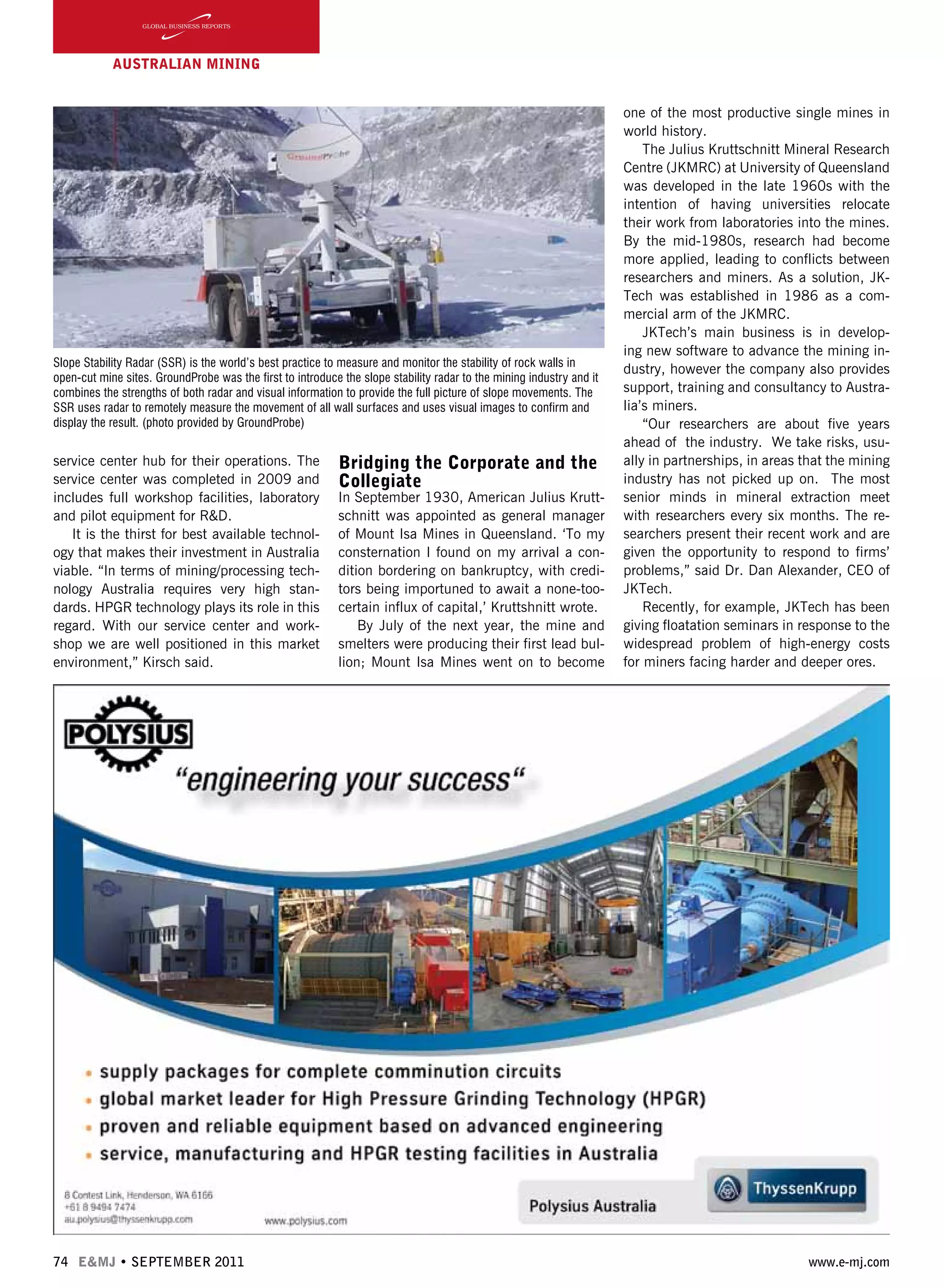
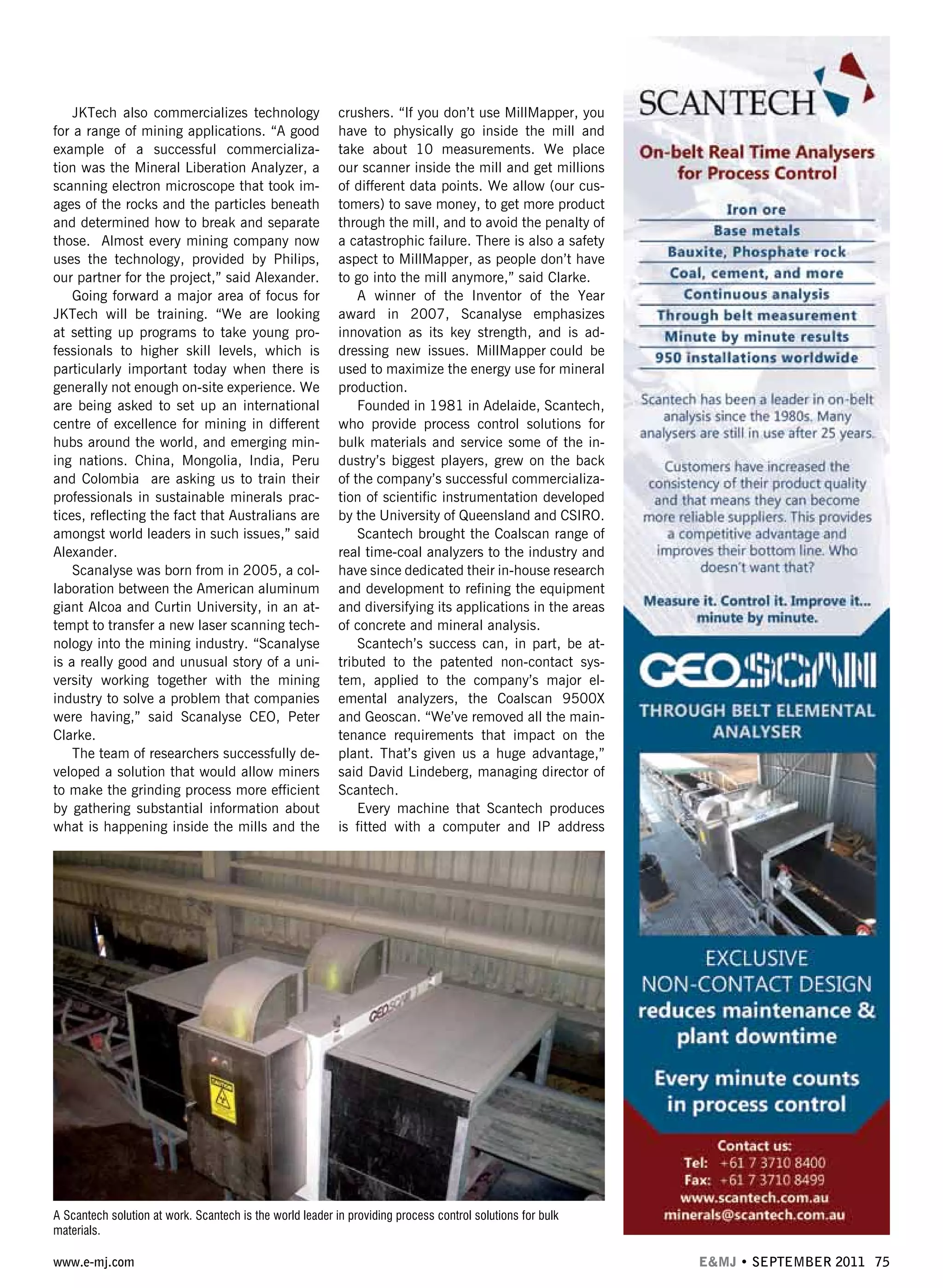
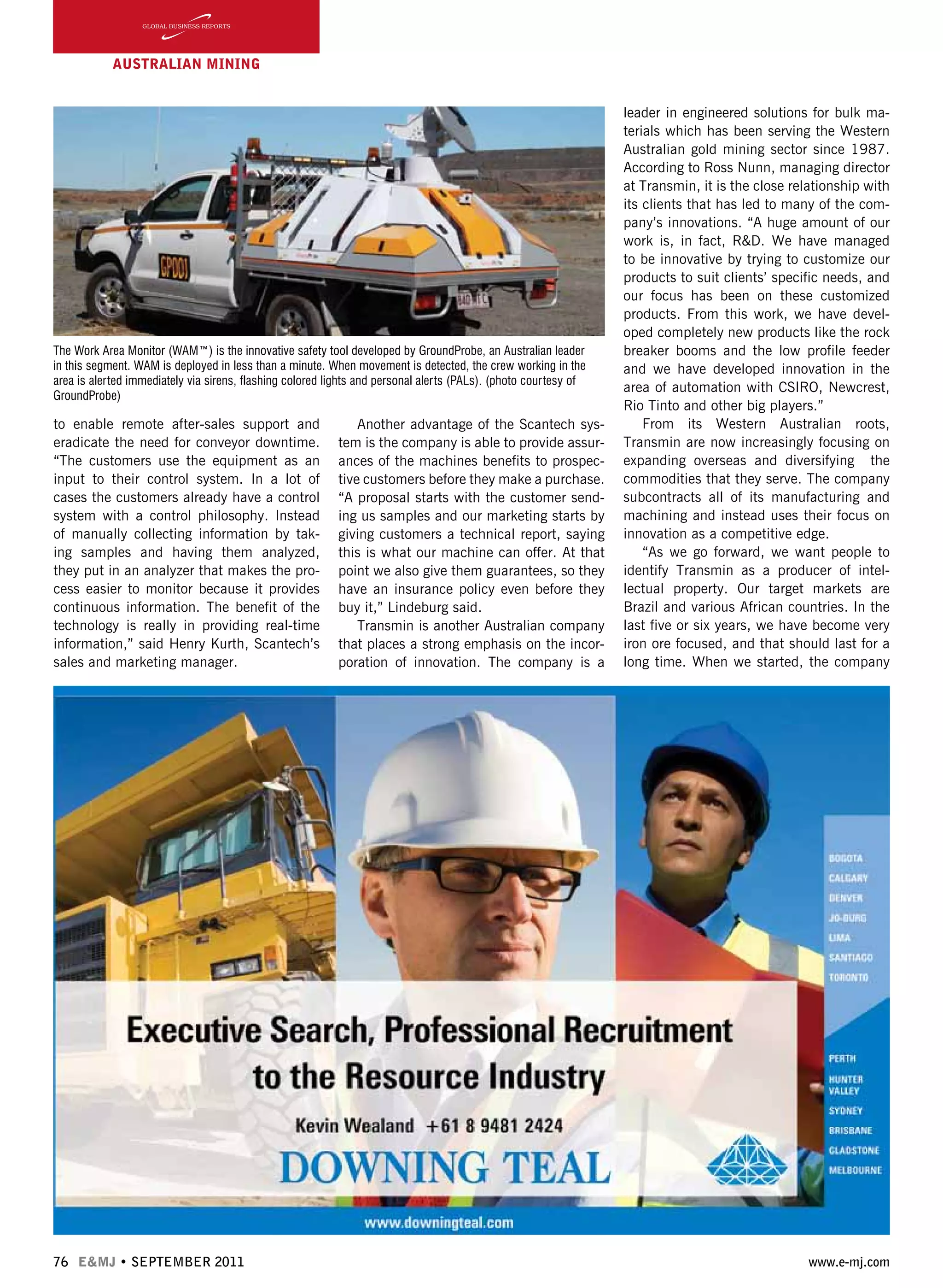


![www.e-mj.com E&MJ • SEPTEMBER 2011 79
walls. “Risk equals probability multiplied
by consequences. As you go deeper and
steeper, the probability is higher, but with
monitoring the consequence is reduced.
Overall, [with the SSR] the risk is on-par or
lowered, but the profitability of an operation
is significantly higher because of deeper pits
and steeper walls,” said David Noon, chief
commercial officer at GroundProbe.
Groundprobe SSR systems is now in 19
countries around the world and, according
to Noon, the company has about 75% of
market share in the global slope stability
radar systems market. While Australia is
traditionally an early adopter of new safety
technology, some jurisdictions like to see a
technology being used widely before they
use it. “There is a strong education com-
ponent in taking a product that is techno-
logically focused into the global market. We
overcame that by focusing on global mining
companies that had safety and technology
innovation as their core values. We were
able to leverage from these early adopters
to become the best practice in the main
market,” said Noon.
In 2011, Groundprobe will release the
Work Area Monitor (WAM). While the SSR
monitors the entire wall slopes of a mine
to determine the overall safety of its opera-
tion, the WAM uses similar technology to
specifically protect the actual operators: the
drillers, blast crews and shovel operators
that frequently work up against the mine
face. The WAM is a much simpler system
and provides an alarm directly to the opera-
tor if a rock movement is detected. “I think
WAM will exceed SSR in terms of numbers
and value to the mining industry. Right
now, there are people working up against
rock faces and there is no monitoring at all.
The WAM is a tool they can have, which
is like their personal protective equipment:
their hard-hat, their boots, and their WAM
when they’re working close to any wall,”
said Noon.
Another company that has taken a po-
tential mining danger out of the mine site is
Immersive Technologies. Mine sites across
the world now utilize some of the largest,
most sophisticated most expensive and
potentially dangerous equipment known to
any sector. Given the high turnover of em-
ployees being experienced across Australia
as the work force constraints bite, training
new operators is a constant concern. Im-
mersive have developed equipment simula-
tors, in partnership with the OEMs, to filter
and then train the operators required to the
highest skill level.
The simulator provides a unique envi-
ronment that is cost effective, safe and in-](https://image.slidesharecdn.com/28c63d64-5f49-4b1f-829f-d9d98c27c114-160115062504/75/Australia_Mining-2011-79-2048.jpg)

